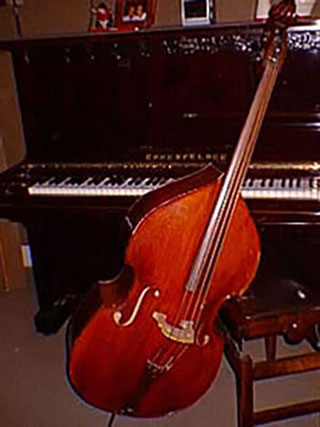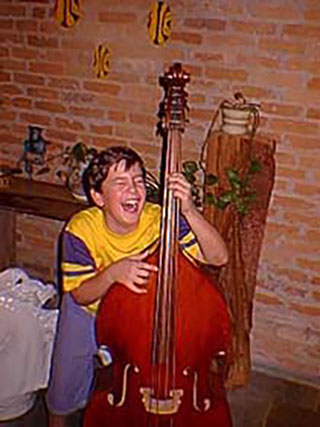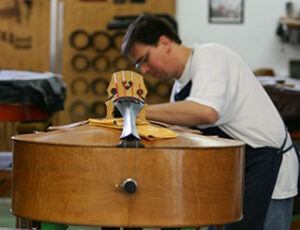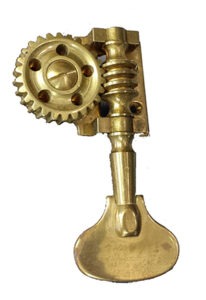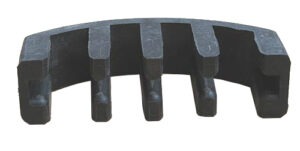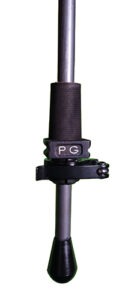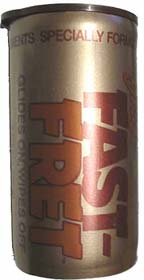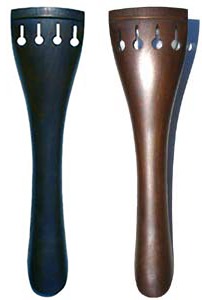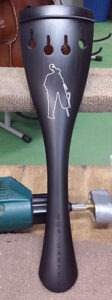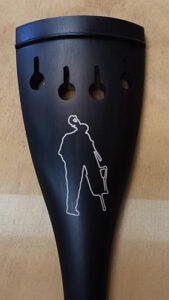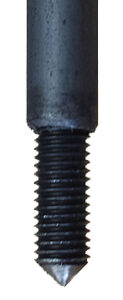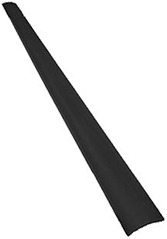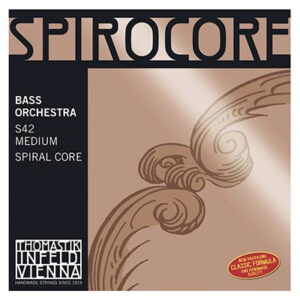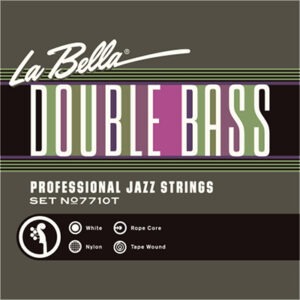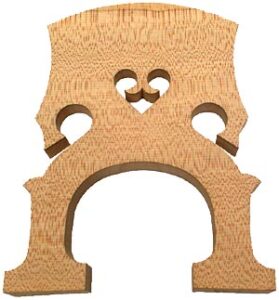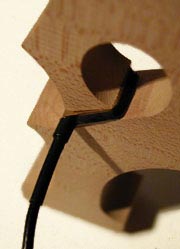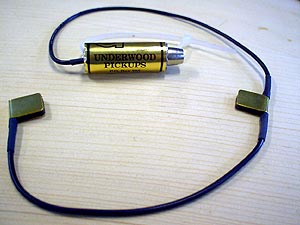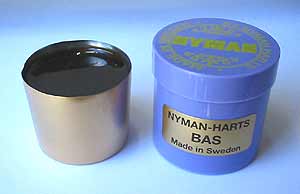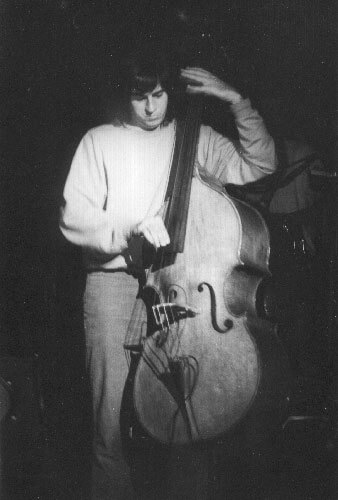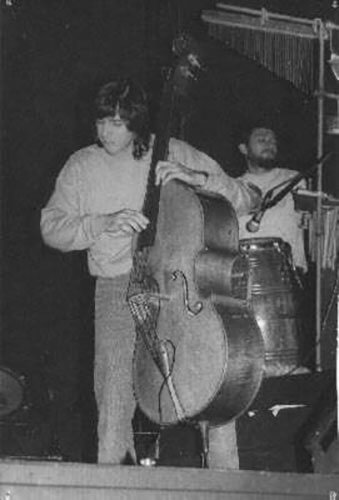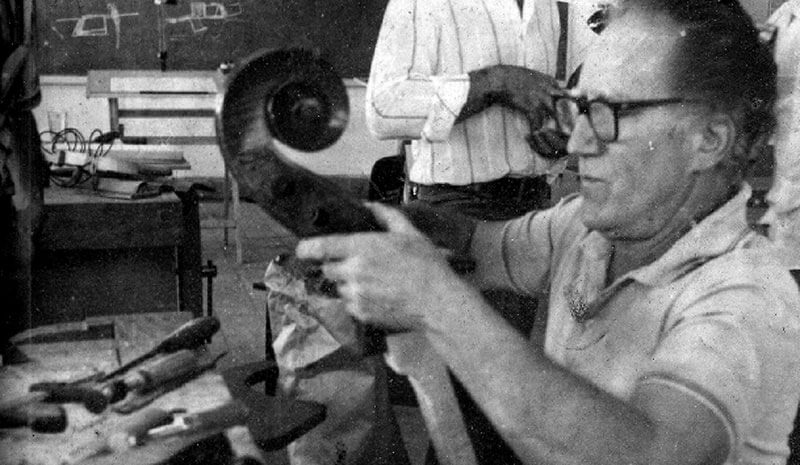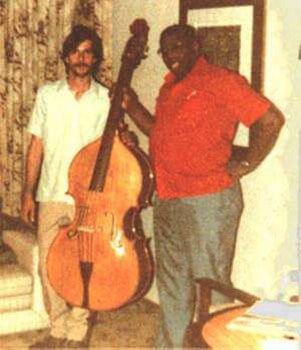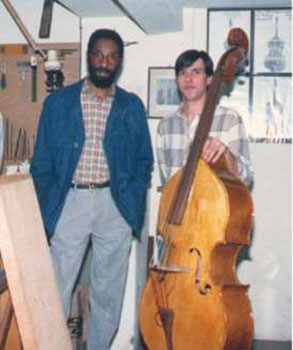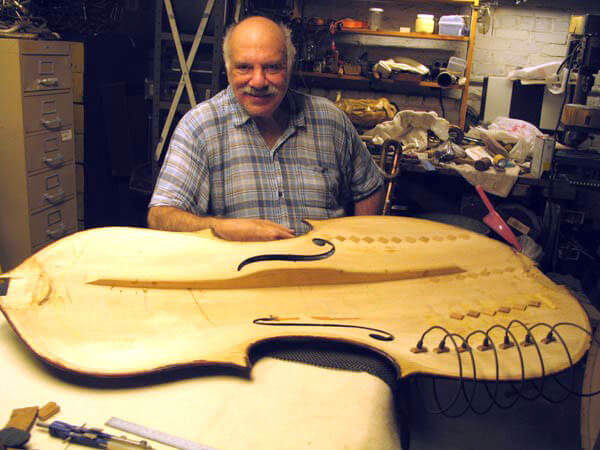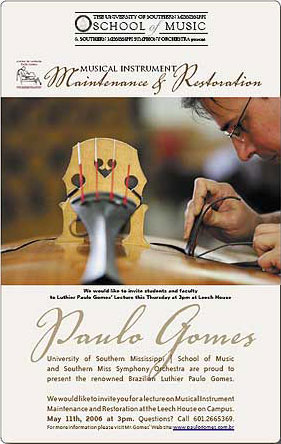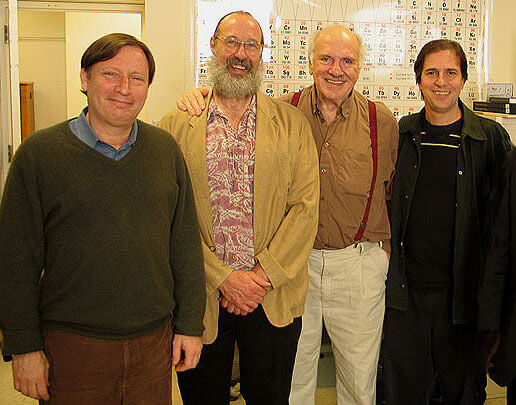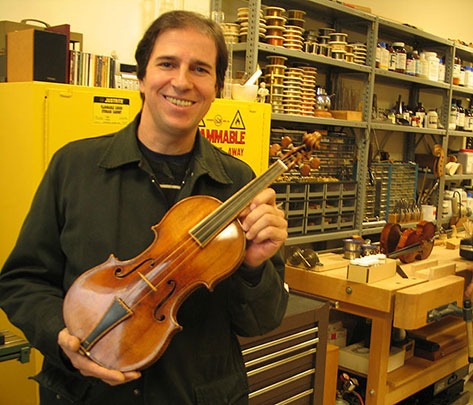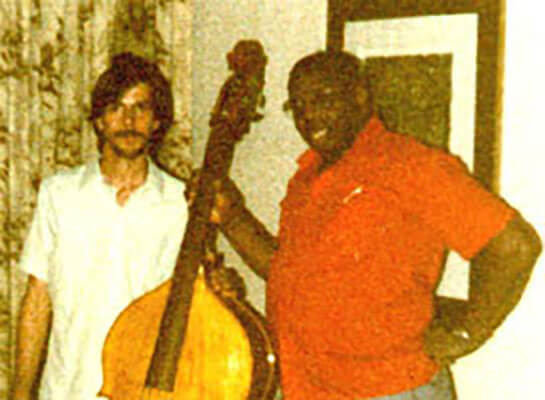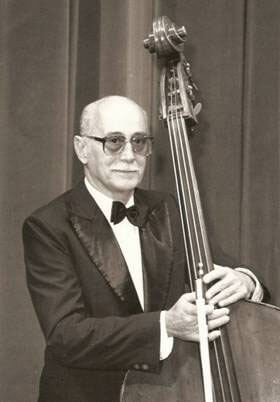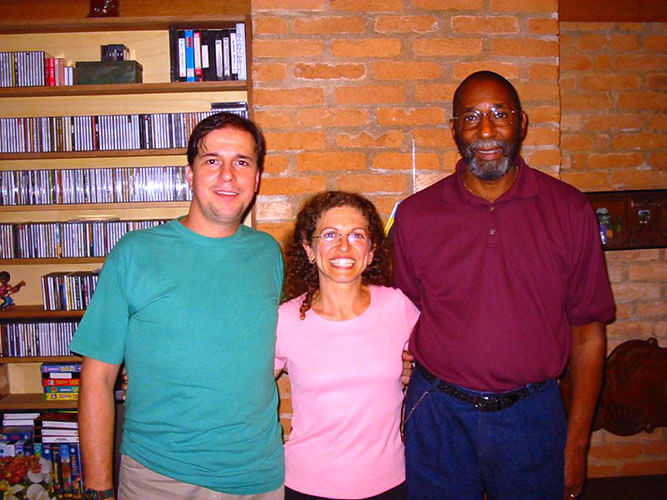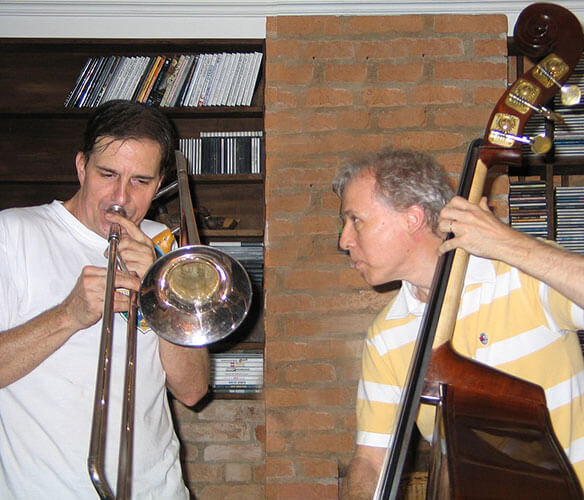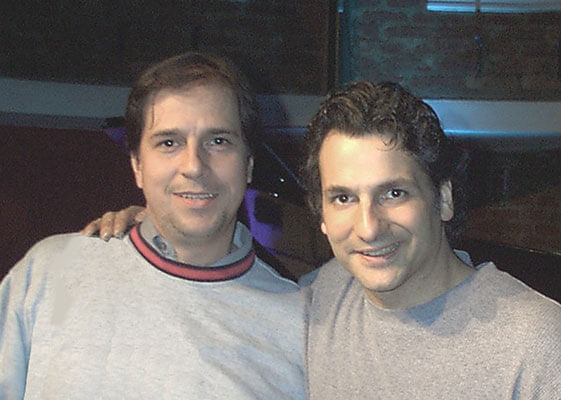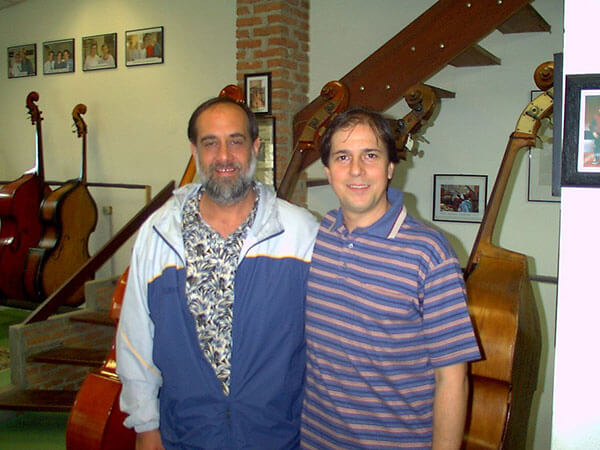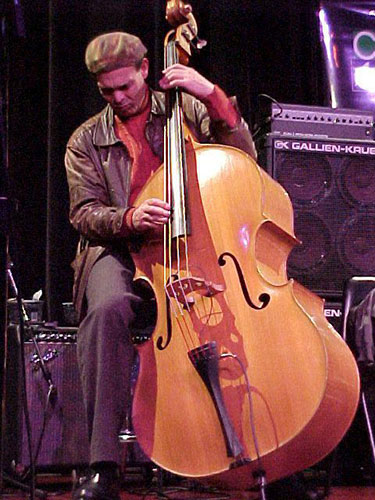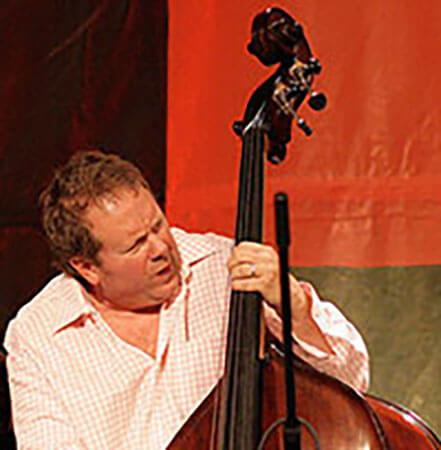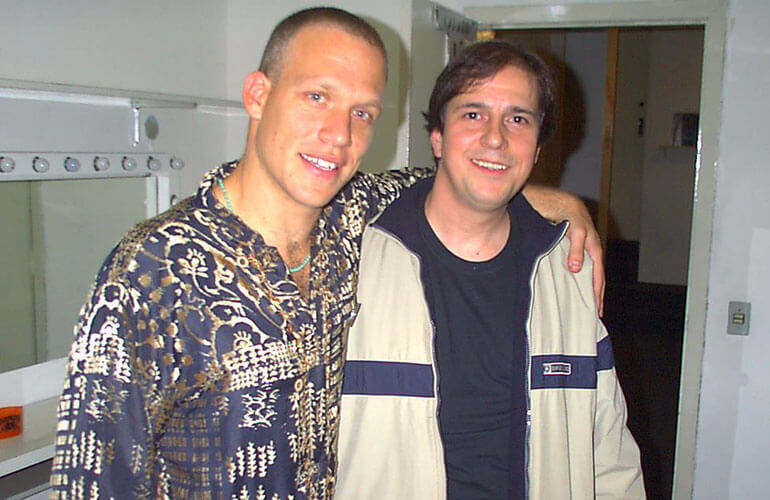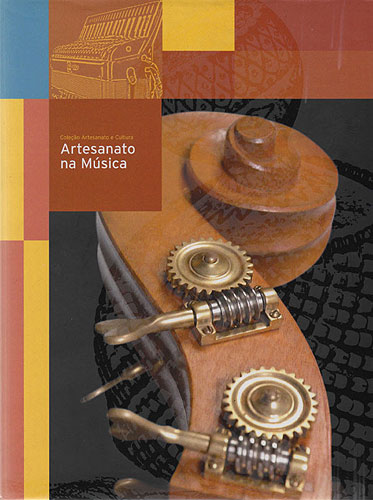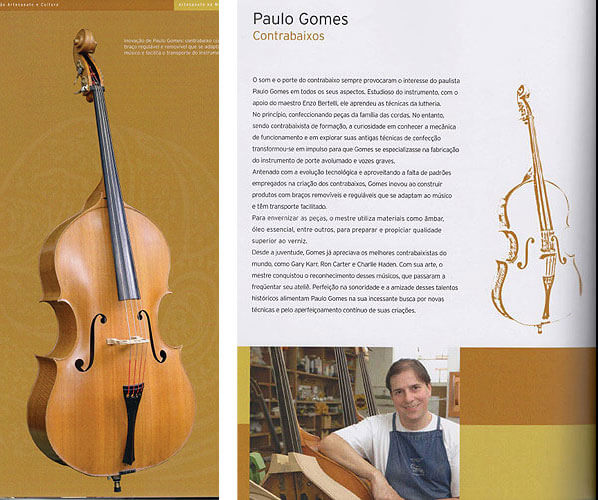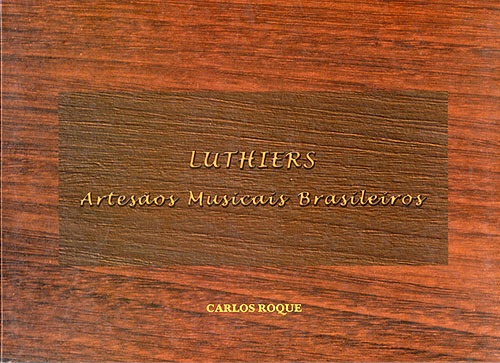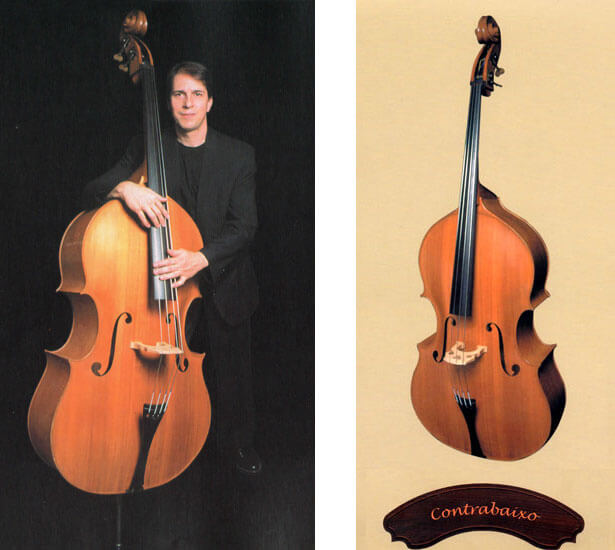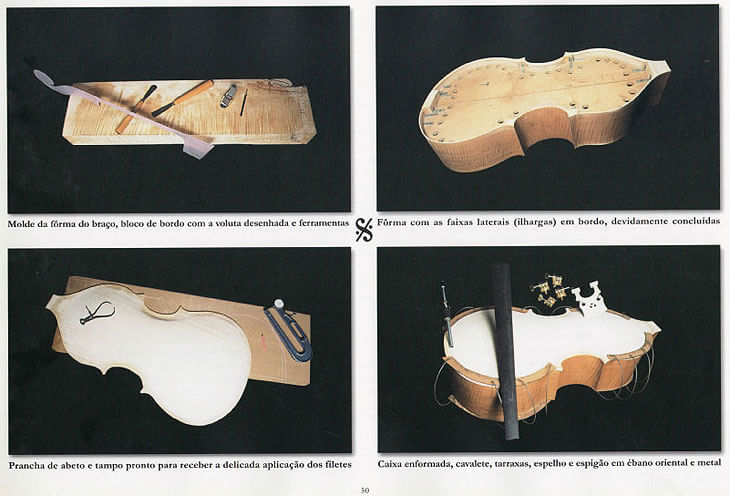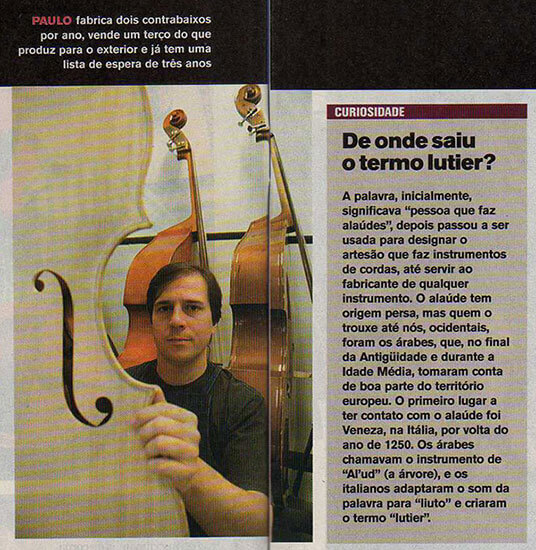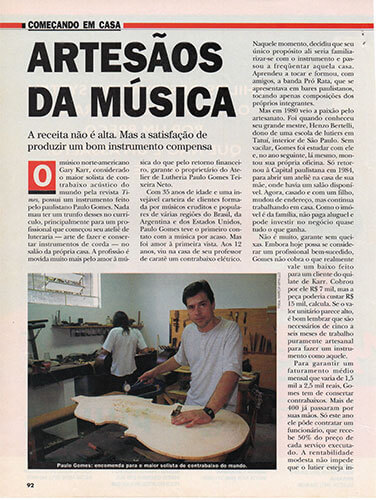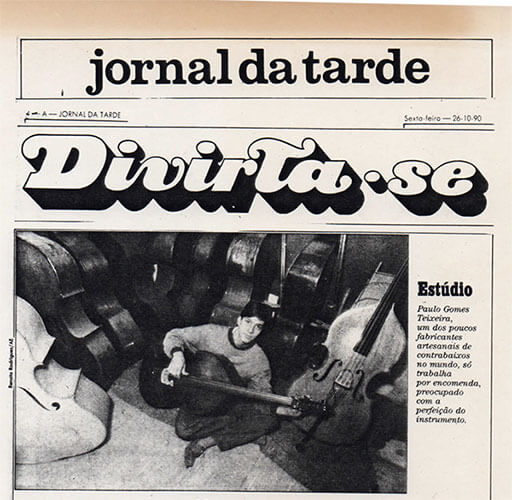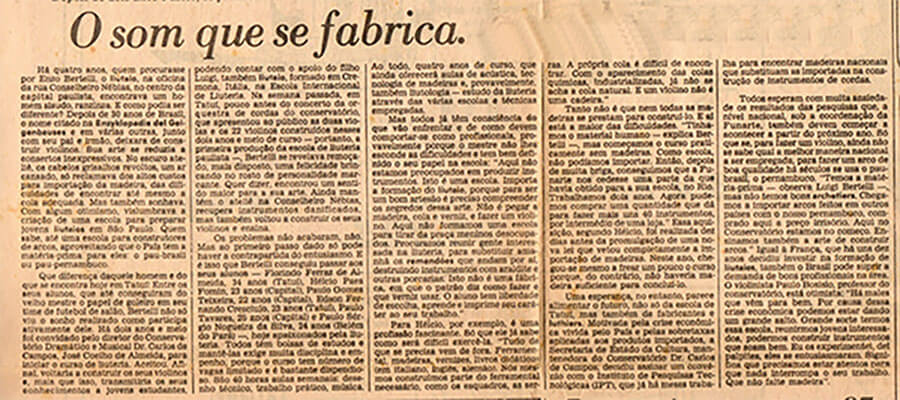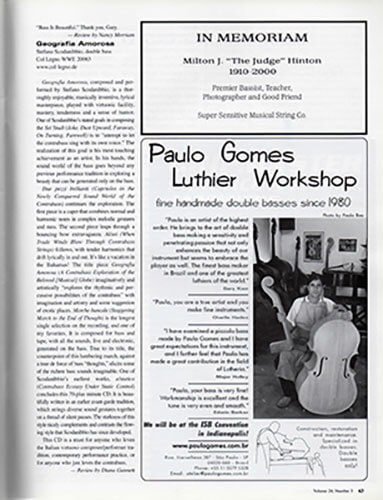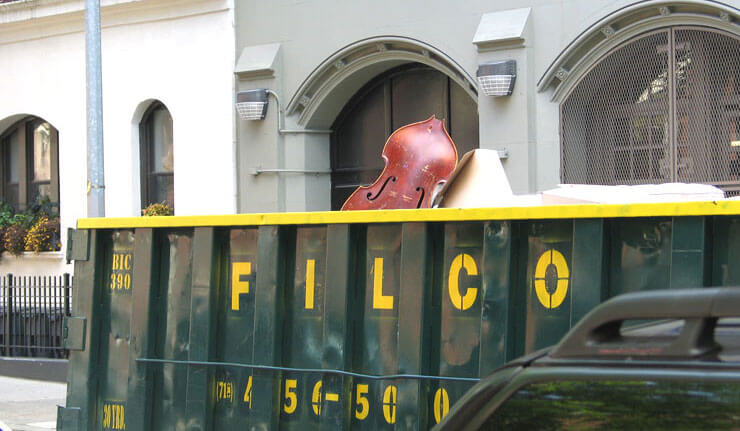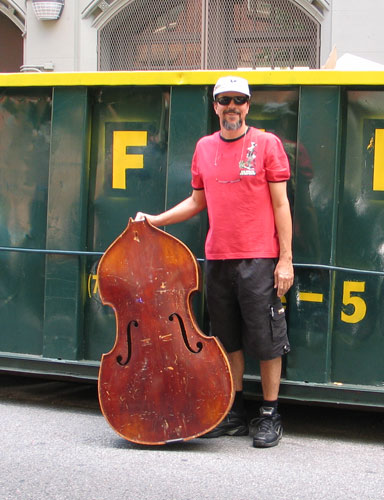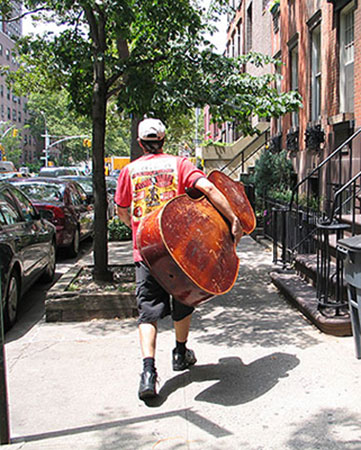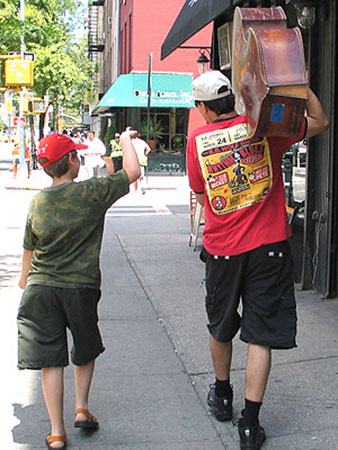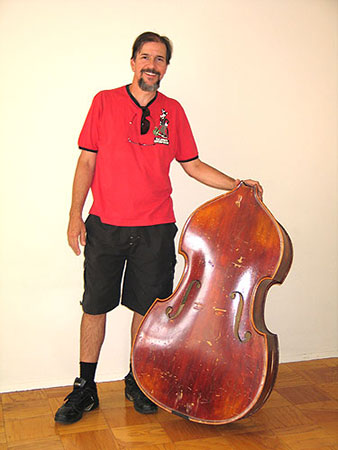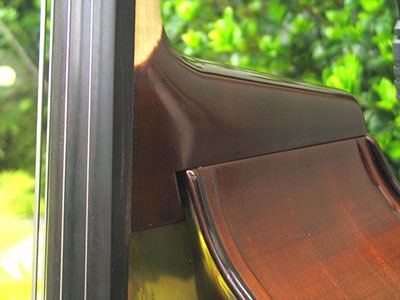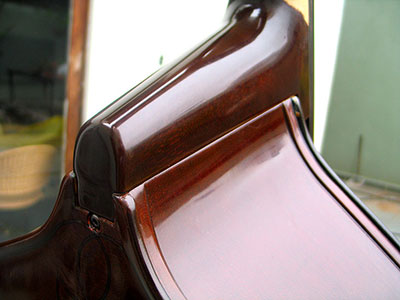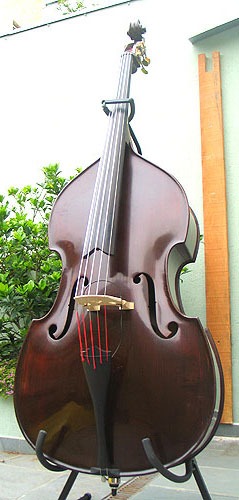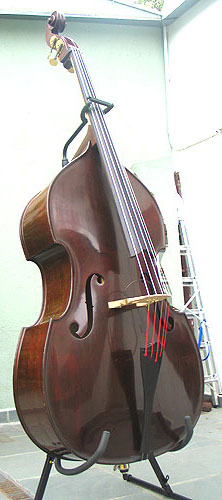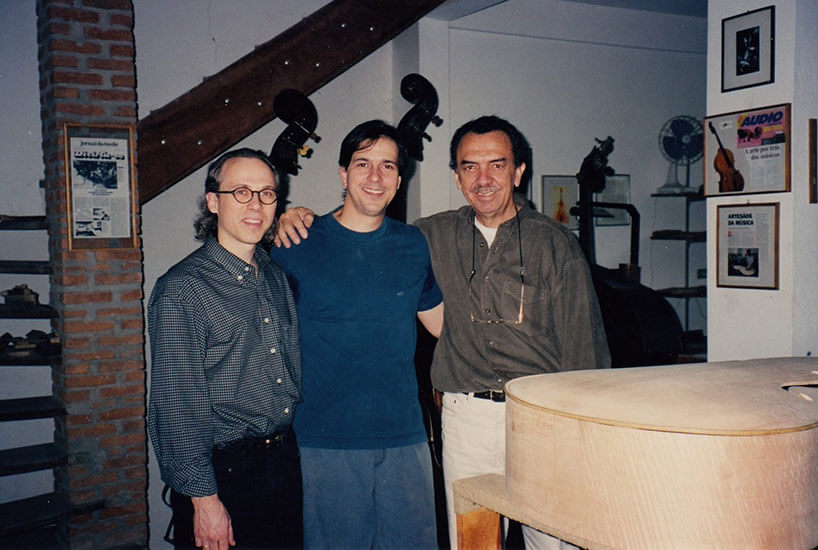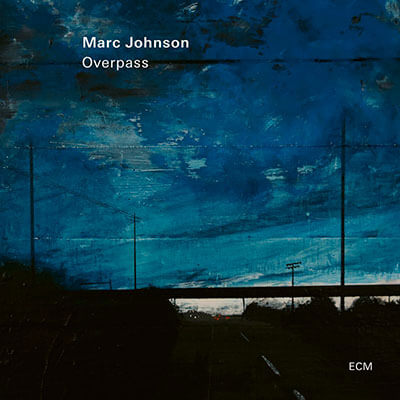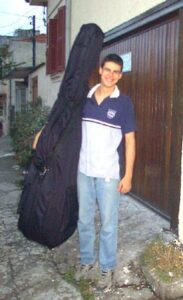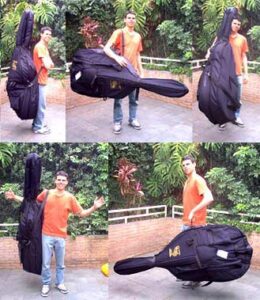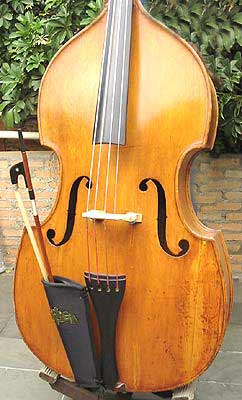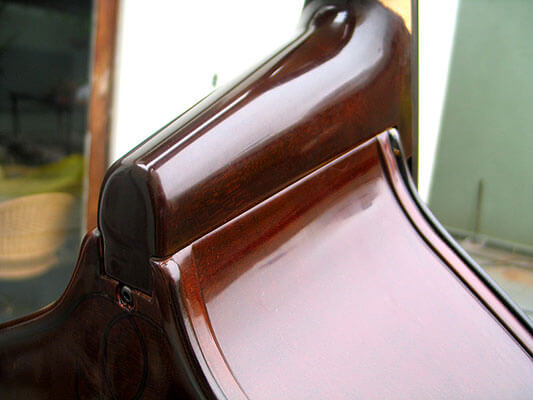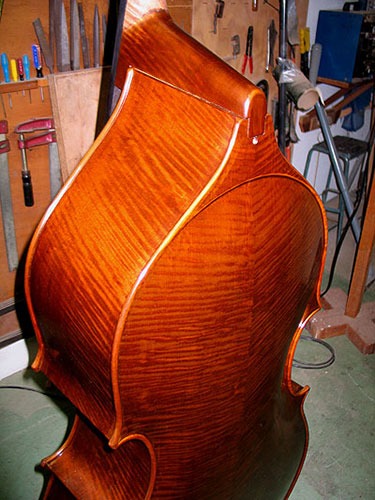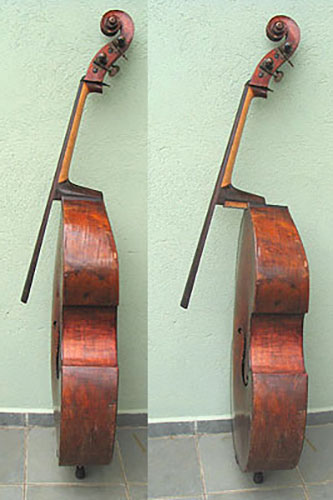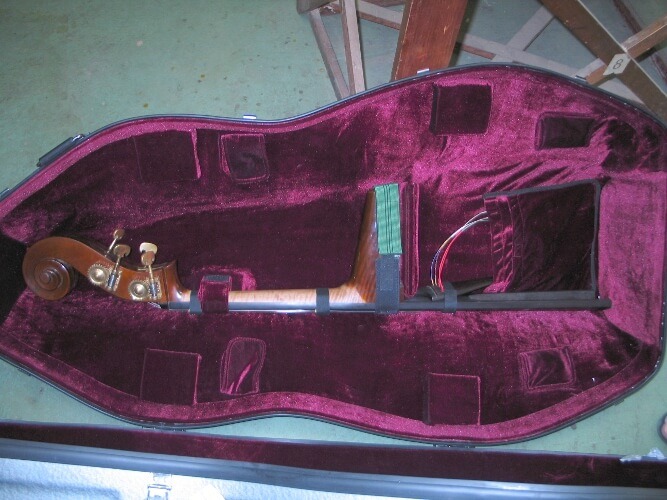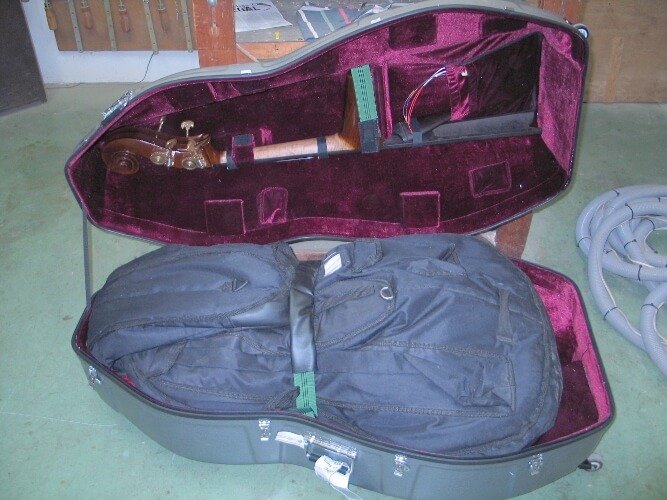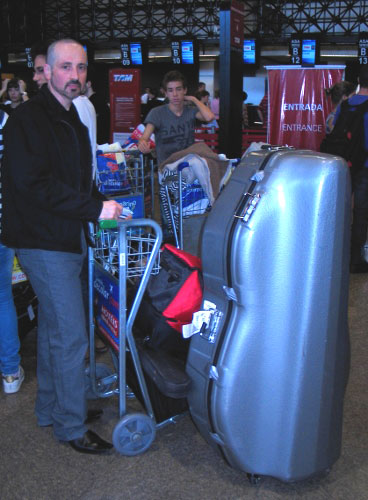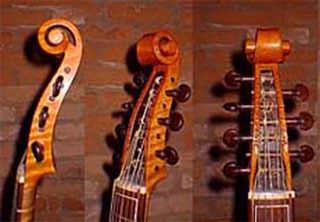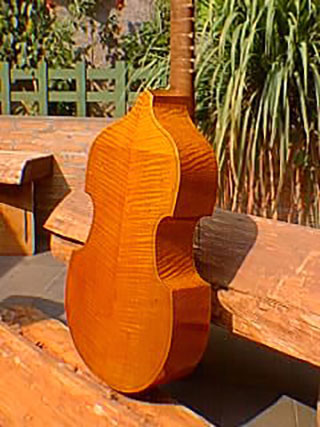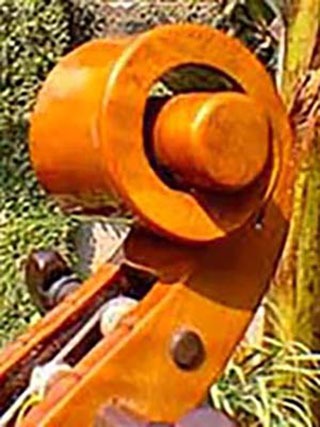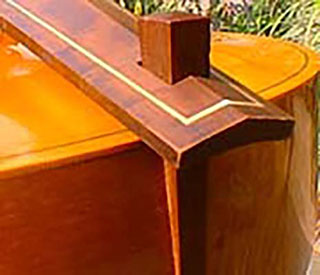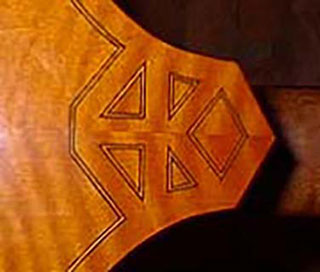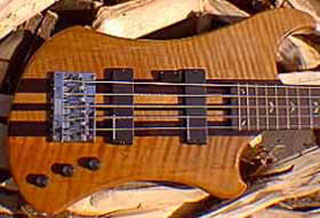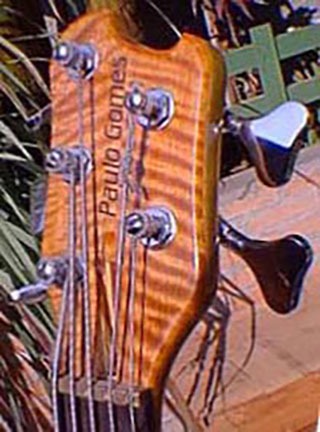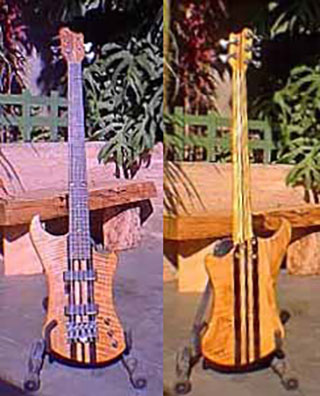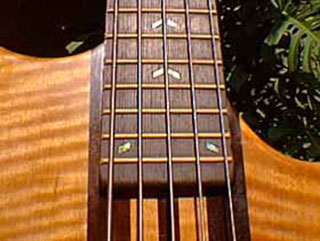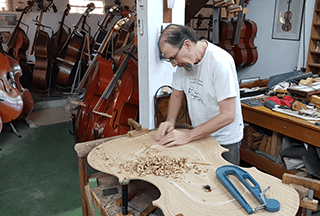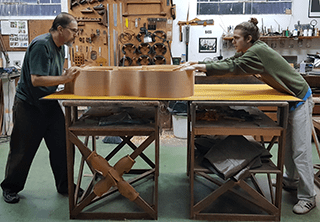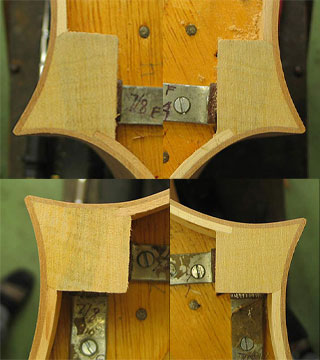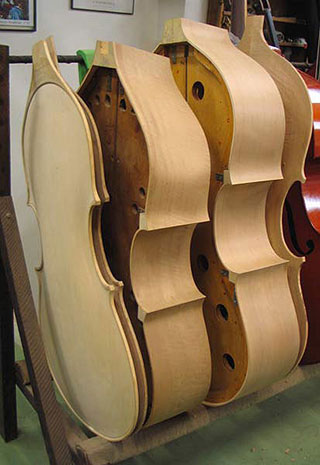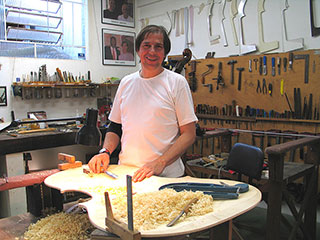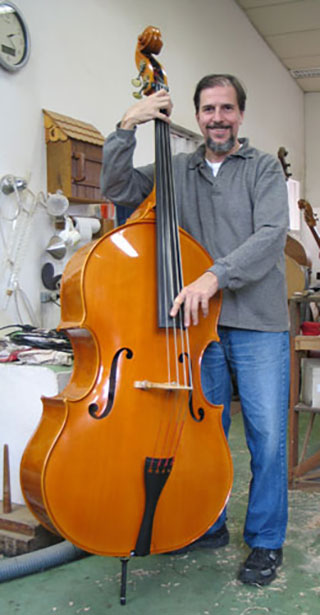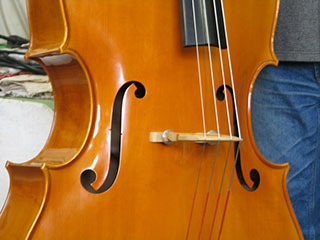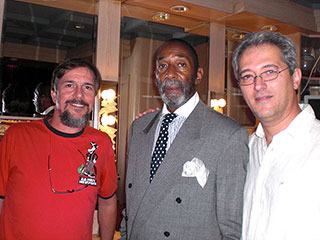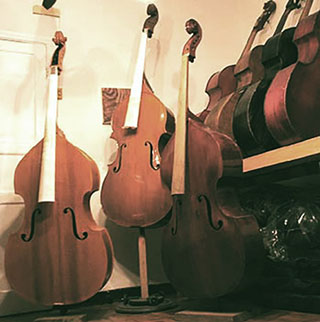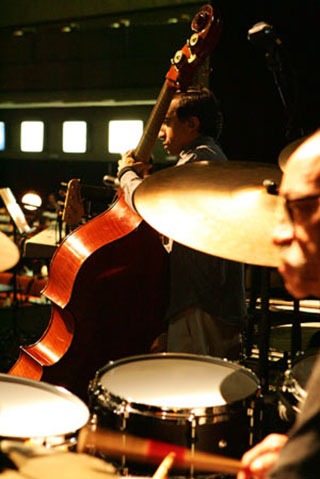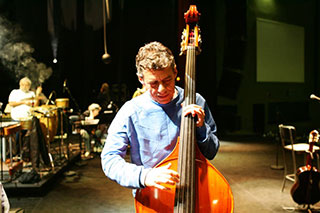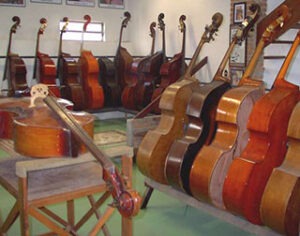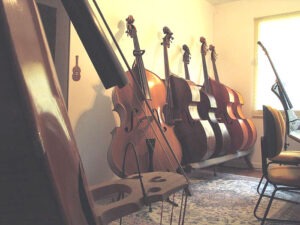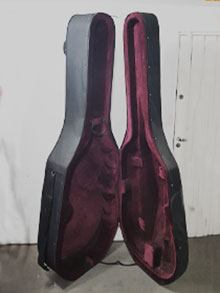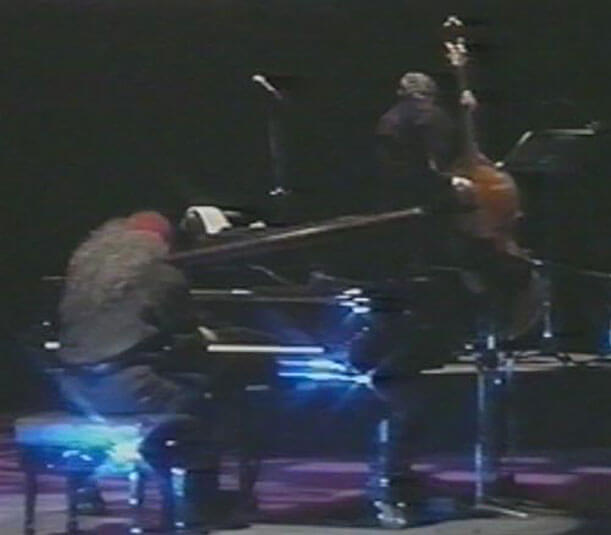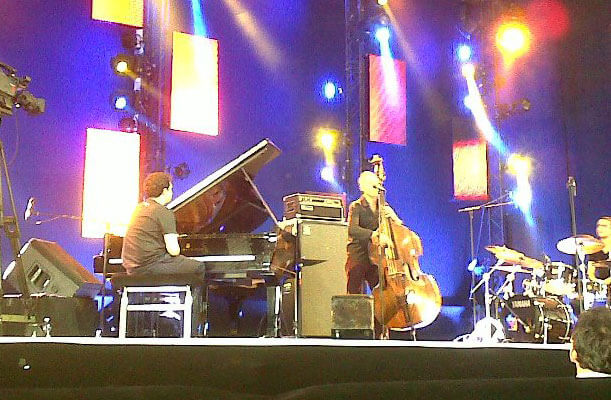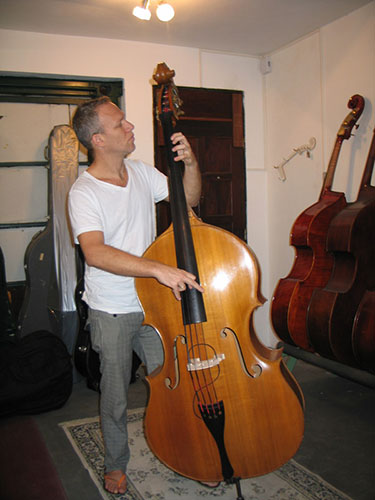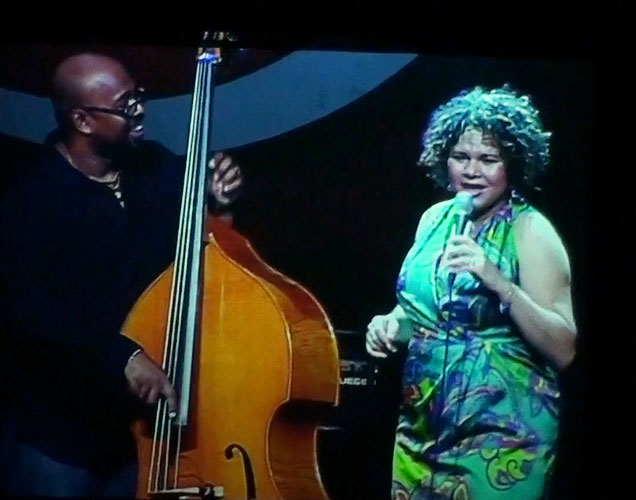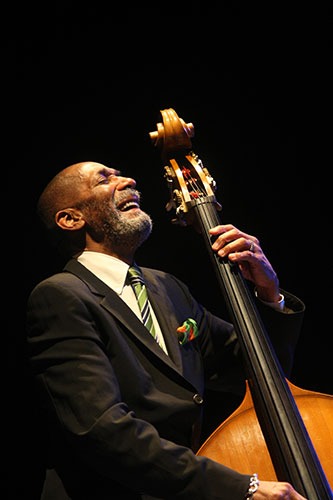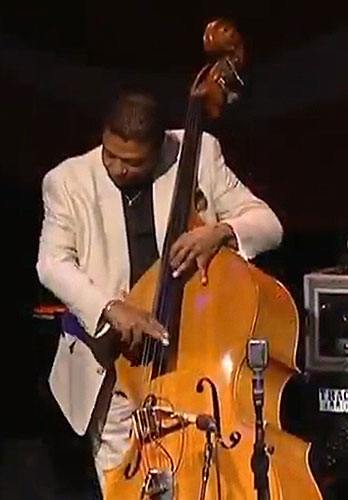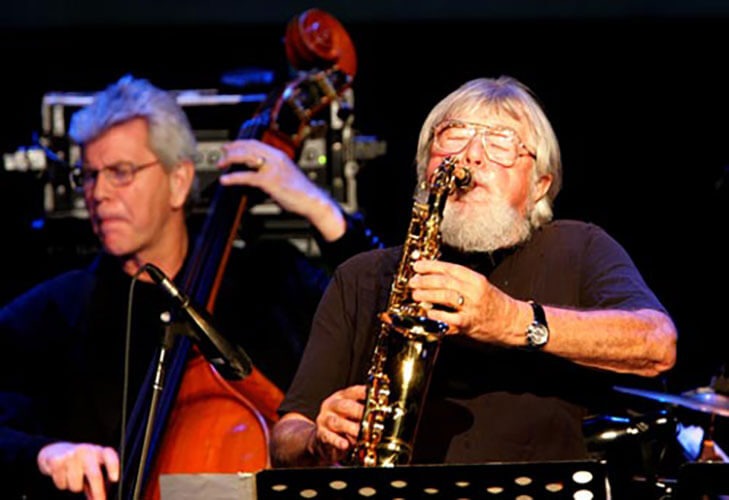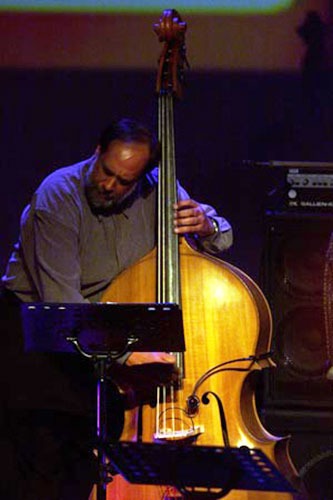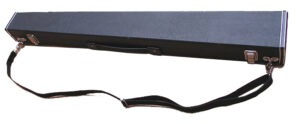Making
Some Double Basses Built in the Workshop
Making
Some Double Basses Built in the Workshop
Gary Karr
In 1992, Gary Karr visited our Atelier.
After getting to know our work and playing an instrument that was still in the final stages of construction, Professor Karr commissioned a double bass of the same model.
That same day, he wrote the following statement:
“…The finest bass maker in Brazil and one of the greatest luthiers in the world…”
The visit of one of the greatest names in the double bass world—internationally recognized and the author of numerous bass recordings—was already an honor and a pleasure. But his intention to purchase one of our instruments was a greater acknowledgment than any compliment.
The instrument, a model I designed, was built using the Italian school technique I learned from my master Enzo Bertelli, combined with the experience gained through decades of work.

Gary Karr playing one of our instruments, still unvarnished, a few days after commissioning his own double bass.
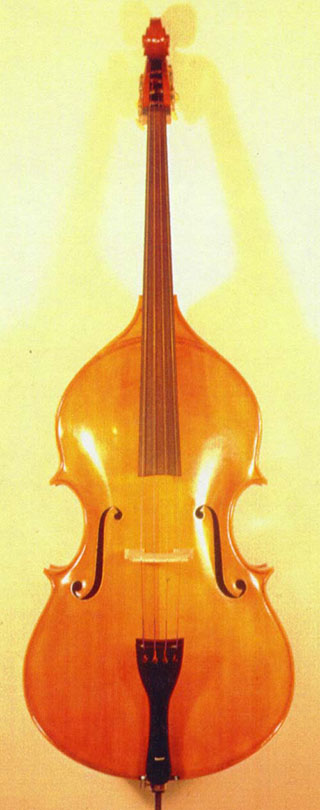

For the construction of this instrument, we used only top-quality materials, as with all our basses.
The fact that the order came from one of the world’s greatest double bassists made every part of the work an immense joy.
Professor Karr liked the unvarnished model he tried at the Atelier very much and requested that his instrument follow the same design.
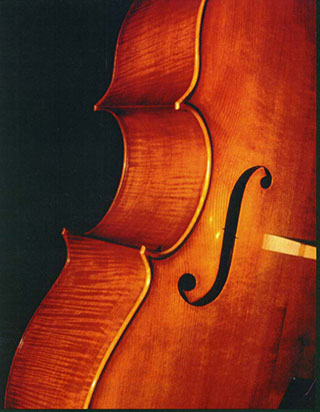


When building a commissioned instrument, every detail is taken into consideration.
The musician must feel completely at ease, so some measurements need to be taken before starting construction.
Every person has their own ergonomic profile, which must be respected in the making of an instrument.

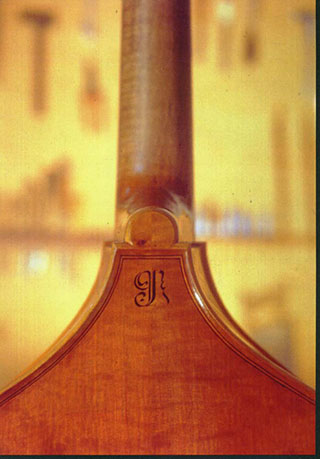
I added a personalized detail at the base of the button.
Every instrument I make has a feature that sets it apart, and in this one, I inlaid Gary Karr’s logo in ebony.
When building a custom instrument, monitoring the process and creating such personal touches is extremely important.
Creating this instrument was one of the most fulfilling and growth-inspiring moments in our Atelier.
I was present at his farewell concert in Indianapolis, and Gary has always been a great friend.
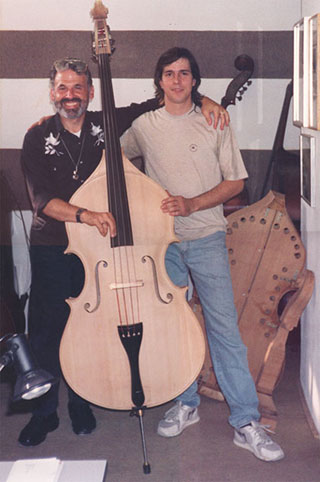
The day Gary visited the Atelier and commissioned his double bass…

… and many years later, in Indianapolis, USA.
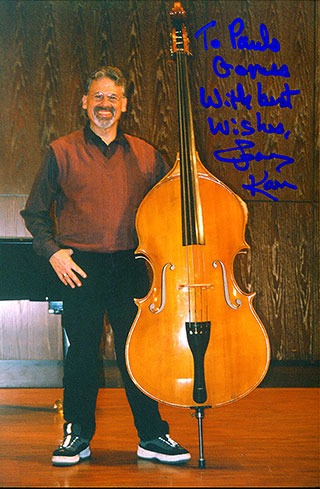
Photo sent by Gary Karr a few years after receiving the new instrument.
Some of Gary Karr’s thoughts on the instrument built for him:
“The varnish is truly beautiful and of high quality, like that of the old masters.”
“…the wood is excellent.”
“…it is very practical.”
“The sound of the bass is like a pleasant voice.”
“…your work is very artistic and reflects the soul of a great master.”
“Thank you for bringing this bass into the world and for allowing it to enrich my life.”
“Paulo is an artist of the highest order. He brings to the art of bass making a sensitivity and deep passion that not only enhances the beauty of our instrument but embraces the performer as well.”
“The most eminent bass maker in Brazil and one of the greatest luthiers in the world.”
“I’m honored to know him.”
Marcos Machado
Marcos hails from Bagé, Rio Grande do Sul, and has built an international career as a soloist, teacher, and chamber musician.
He is a professor of classical and jazz double bass at the University of Southern Mississippi in Hattiesburg and principal bassist of the Meridian Symphony Orchestra.
A virtuoso endowed with remarkable talent and musicality.
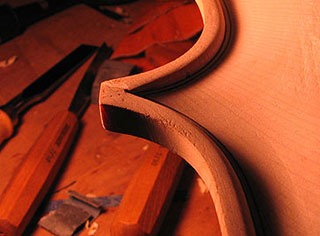

Detail of the “rope” style edge.
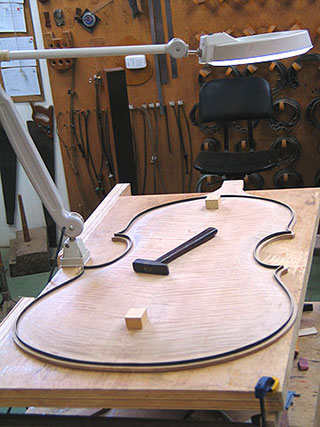
The back being purfled.

For personalization, I crafted an “M” at the end of the fingerboard and, later, another “M” in negative at the end of the tailpiece with the fingerboard.
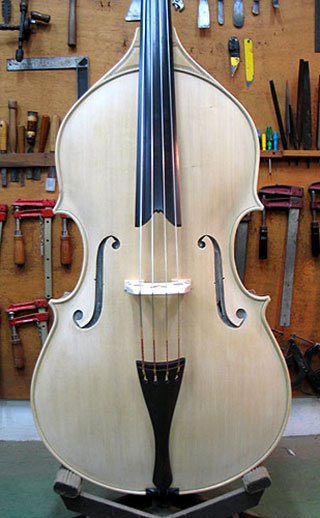

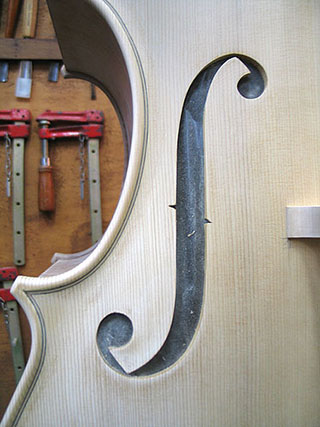
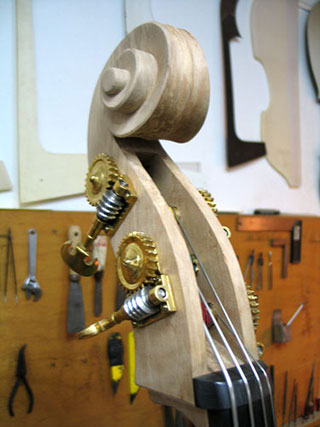
The double bass assembled, played, and ready, before heading to the ultraviolet chamber and then being varnished.
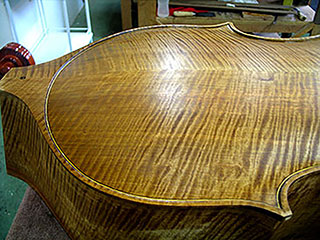
The beauty of the wood truly impresses.

The double bass finished, on the day Marcos came from the USA to pick it up.

This instrument was built with our Adjustable and Removable Neck System.
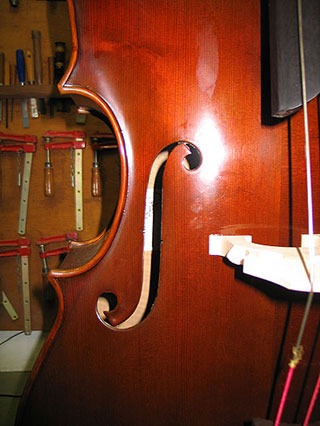
The edge is slightly lighter than the rest of the wood, giving a very soft outline.


A special moment: playing, for the first time, a double bass made exactly as envisioned.
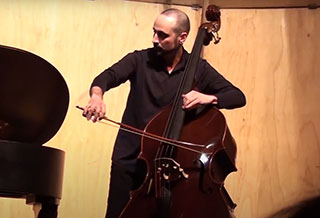
Watch videos of this instrument’s debut by clicking here.
Matthieu Hébrard

The instruments of the Frenchman Matthieu and our Sizão Machado were built together.

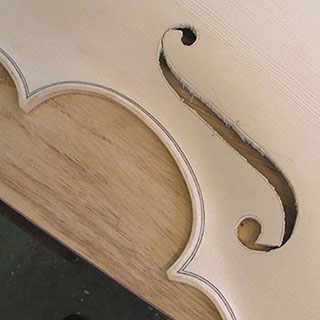
Matthieu’s is a 7/8 four-string double bass, and Sizão’s is a 3/4 five-string.

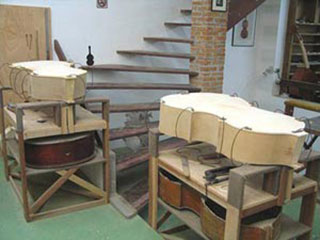

We consider these basses “siblings.”

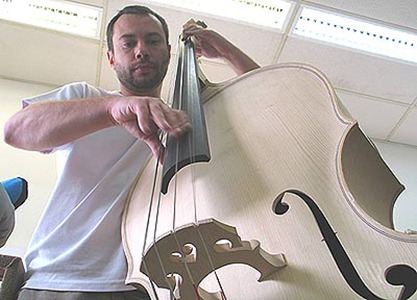


Matthieu on the day the bass was played for the first time and was ready to be varnished.
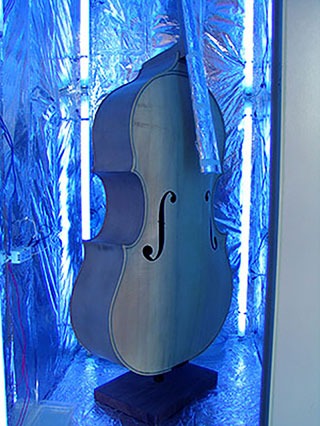
The bass in the ultraviolet light chamber, being “tanned” before varnishing.

With the varnish already dry on the day the bass left the Atelier.
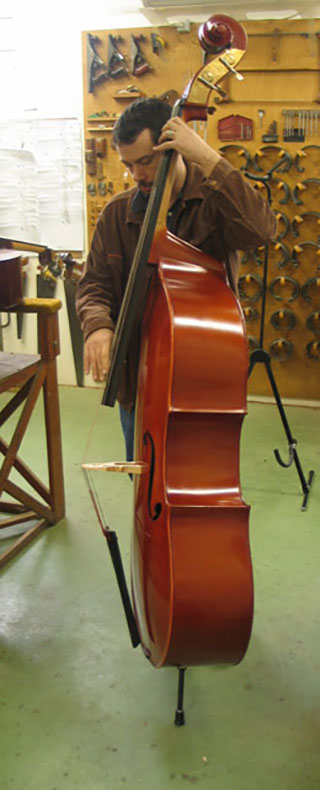
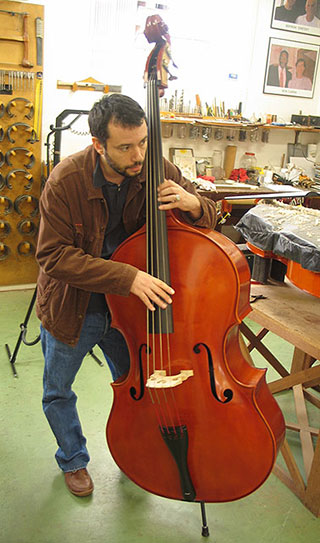
It’s hard when the instrument finally goes to its new home, but the joy of seeing a satisfied musician is immense.
Sizão Machado

It seems that Sizão is very pleased with the construction of his double bass.
Building an instrument for a musician of this caliber is an honor and a great satisfaction for us.


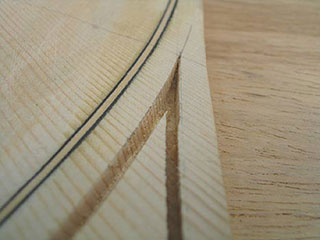

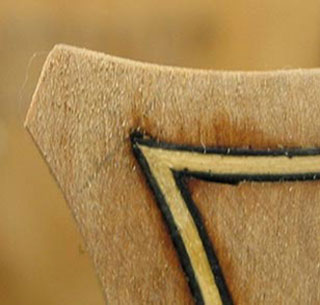

Details of the purfling application and the already purfled edges.
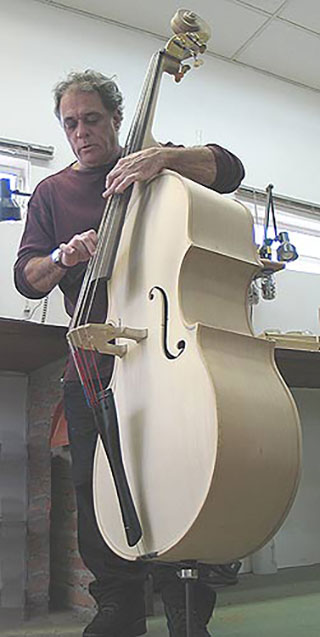

The mutual respect and affection among friends make our work an incomparable pleasure.
One of the advantages of commissioning an instrument is the ability to follow the construction process and play the bass before varnishing, allowing for some personal taste adjustments.
Below are some photos of the finished instrument.
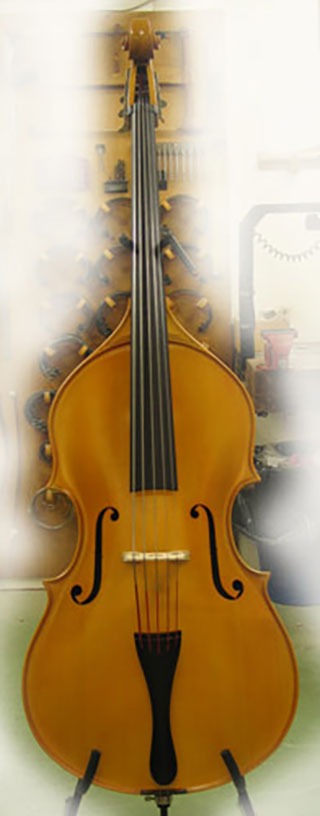


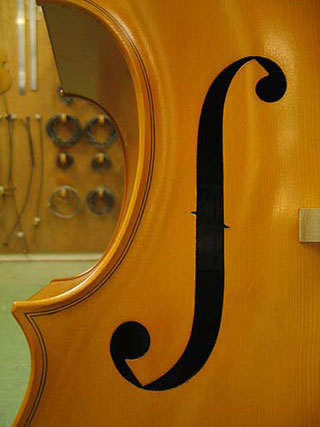

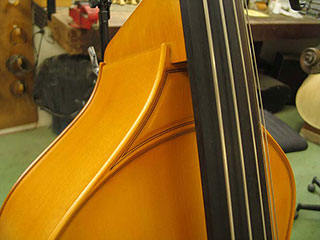
All the details that make our double basses unique pieces.


The joy on our clients’ faces gives us the certainty of a job well done.
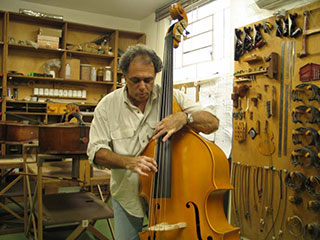
Watch several of Sizão’s performances with his bass here.
Learn more about Sizão Machado from his own promotional text:
A self-taught artist and creator of a musical language that goes far beyond the realm of his instrument, bassist Sizão Machado is internationally recognized for his performances alongside Chet Baker, Herbie Mann, Elis Regina, Jim Hall, Chico Buarque, Dori Caymmi, Djavan, Milton Nascimento, Ivan Lins, Joyce, Flora Purim and Airto Moreira, Roberto Menescal, Noite Ilustrada, Jean & Paulo Garfunkel, the Jobim Family, Paulo César Pinheiro, and many others, always leaving his mark wherever he plays.
His conception, rhythm, and “violinistic” harmonizations transposed to the double bass, combined with exceptional taste and sophistication, make his unmistakable style recognizable in any musical genre. This is a privilege reserved for few and truly great instrumentalists.
In addition to his performances on stages around the world, Sizão has participated in the recording of over a hundred albums with a wide variety of artists. In his solo album, *Quinto Elemento*, Sizão Machado compiled original compositions and carefully selected pieces from his eclectic career. Highlights include *Stanats*, an unreleased theme by maestro Moacyr Santos, *Amparo/Olha Maria* by Tom Jobim, Chico Buarque, and Vinícius de Moraes, recorded with six double basses, and *Anu Preto*, *Quinto Elemento*, and *Samba da Mãe*, of his own authorship.
Currently, in addition to running his own studio, In Sonoris, Sizão presents his work in various formations alongside great instrumentalists and accompanies performances and recordings with Quinteto Sambazz, Terrêro de Jesus, singer Renato Braz, and composers Celso Viáfora and Jean & Paulo Garfunkel.
Sizão Machado teaches courses in musical sensitivity, band practice, and instrument instruction at the Tom Jobim Center for Musical Studies (formerly Universidade Livre de Música – ULM) and at Souza Lima Berklee College.
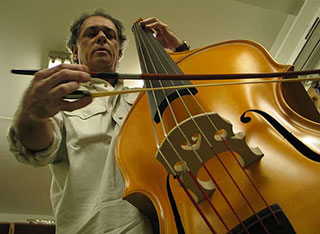
Luiz Chaves

I hold dear the memory of my beloved friend Luiz, and for that reason, I keep these pages to always remember a joyful and happy Luiz with his instrument, which I built with so much pride.
Luiz was an affectionate person who loved spending afternoons at the atelier, chatting and laughing with us.

Below, photos of the construction of this instrument.
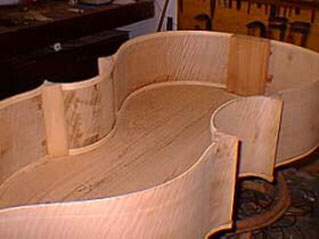
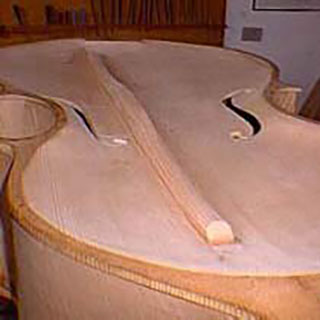

Playing the instrument before varnishing is one of the advantages of commissioning its construction, as some adjustments can be made.
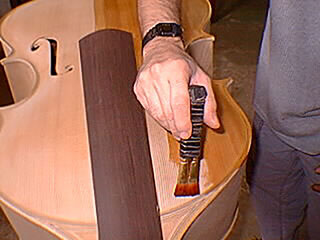

The varnishing process with varnish prepared by us, using our own formula
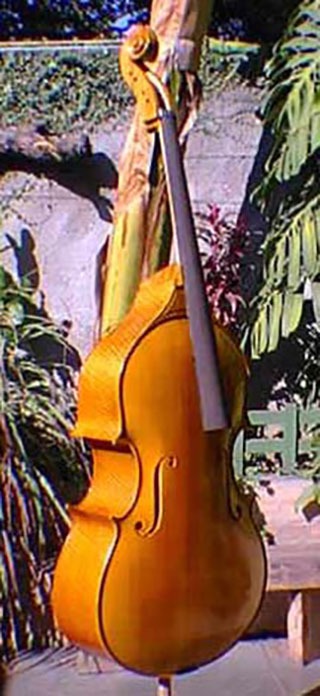

Between coats, the instrument basks in the morning and late afternoon sun.
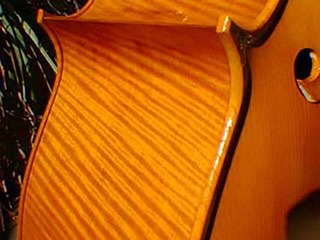

The long-awaited day of picking up the instrument and taking it home.
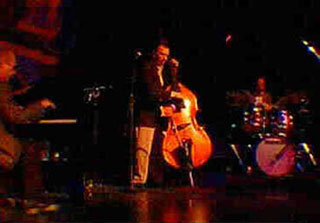
The first performance of the Zimbo Trio with the double bass.

Jorge Helder

An internationally recognized musician of great talent, Jorge needs no introduction to any double bassist.
Building this instrument strengthened our friendship.


The scroll, freshly carved, and one of the edges of the top, already purfled.


Throughout the varnishing process, the double bass is alternately placed in the gentle morning and afternoon sun.

The bass, nearly finished, in the varnish room, drying alongside other instruments in the same stage.

Jorge has already made numerous recordings and performances with his new bass.


It wasn’t just Jorge who fell in love with the instrument. The “Caviar Left” also recognizes a fine instrument, and during a season in São Paulo, Chico Buarque had the pleasure of “playing” our bass.
Edvard Debess
Another international musician commissioning the construction of a new double bass.

This is Edvard Nyholm Debess, a double bassist from the Faroe Islands (near Denmark).
Edvard came to Brazil to commission the construction of his new instrument and spent over a week in our country.
His bass was built, and he returned to pick up the finished instrument in February 2006.
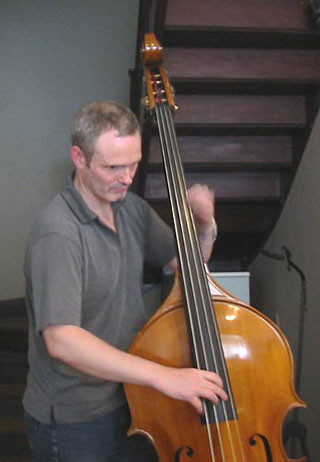
Edvard tries out a bass built in the Atelier and confirms the expectations he already had for the instrument. His new bass would be a 3/4 with four strings.
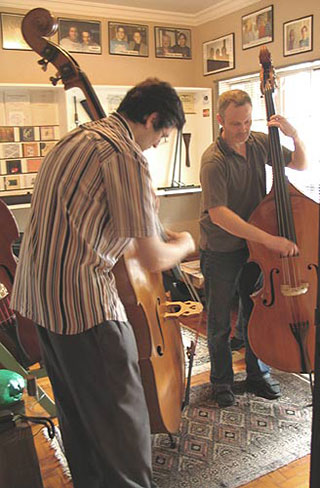
Playing with Célio Barros.
The visiting room was filled with the sound of two instruments built by Paulo Gomes.
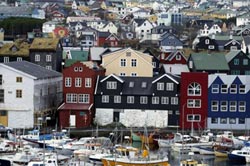
This is Tórshavn, Edvard’s hometown in the Faroe Islands.
Though he has lived elsewhere, he always returns to his roots.
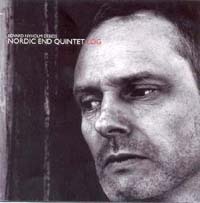
In addition to being a jazz double bassist, Edvard is the principal bassist of the Faroese Symphony Orchestra, composes music for his CDs, and writes for various ensembles.
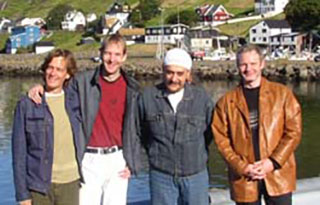
Edvard is familiar with some of our music as he is part of the Gismonti Project with Egberto Gismonti, Jonas Johansen, and Flemming Agerskov.
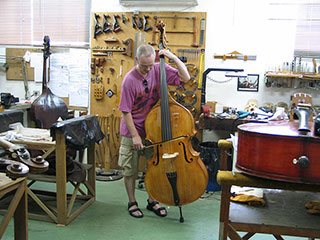
Edvard at the Workshop, playing the fully completed instrument.
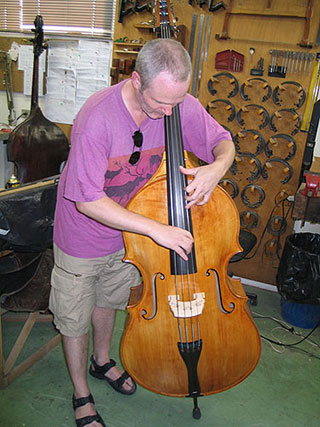
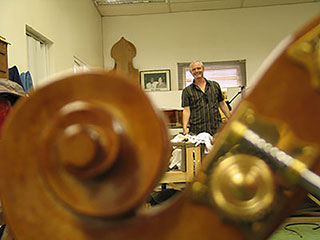
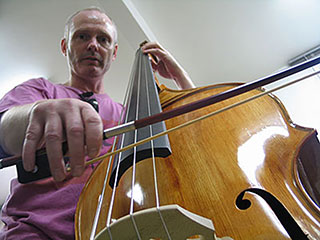
Edvard is a highly talented musician and a really great guy.
He came with his family, and we became great friends.
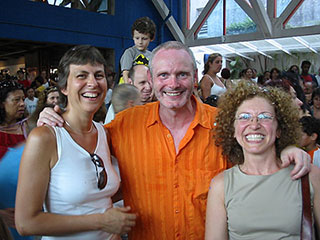
Birgit (his wife), Edvard, and Edna experiencing a carnival dance.
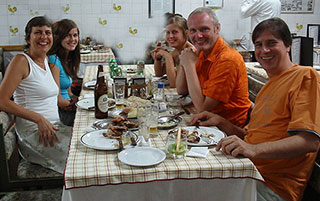
Birgit, Lisa, Iben, and Edvard.
The whole family, along with Paulo, at a restaurant.
This is the first email Edvard sent when he arrived home with the instrument:
“Hey Paulo, a million thanks for all your help, kindness, and hospitality when we were in São Paulo.
All of you made our stay memorable for the entire family 🙂
We had a wonderful trip to Brazil and enjoyed every minute!
The bass made the journey without a scratch, and I didn’t even pay any excess weight fees anywhere.
We arrived on Thursday, and by Friday night, I started a studio session with the new bass.
I intended to record with two tube mics, but ended up using just one microphone, and it sounded great.
The tone is so clear, clean, and articulated, and the deep tones keep developing over time. The more I play, the richer the sound becomes!
Moreover, the shape, size, and varnish suit me perfectly, so if you aimed to infuse some of my musical personality into this instrument, I think you succeeded brilliantly.
Excellent work, Paulo. Thank you for your tremendous effort on this bass.
I’m deeply grateful and will take good care of the instrument!”
Daniel Marques
Another instrument built to “live” abroad.
This bass was commissioned by Daniel Marques, who resides in Florida, USA.
Since he was far away during the entire construction process, he couldn’t personally oversee the work.
To add to the challenge, Daniel is left-handed, so I had to “play” the bass myself to achieve the best setup.
For me, it’s very difficult to play anything with the strings reversed, but the challenge was the best motivation.

Details of the edges with perfect fittings

Daniel’s bass, a 7/8, behind Marcos Machado’s 3/4. Both basses were built together.








The joy of creating an instrument is always present in every stage of the construction.
The only issue is that, since Daniel is left-handed, the bass has the soundpost and bass bar reversed, and with the strings also inverted, it’s impossible for me to play anything.


I hope to have photos of Daniel playing the instrument to share here.
This bass is another one heading far away, and it’s always hard to see the instruments leave.

Taking advantage of another work trip to New York, I personally brought the instrument to the USA and delivered it to Daniel at the Blue Note, where we went to see my friend Ron Carter.
It was a very special night for both of us.
Gary Karr
In 1992, Gary Karr visited our Atelier.
After getting to know our work and playing an instrument that was still in the final stages of construction, Professor Karr commissioned a double bass of the same model.
That same day, he wrote the following statement:
“…The finest bass maker in Brazil and one of the greatest luthiers in the world…”
The visit of one of the greatest names in the double bass world—internationally recognized and the author of numerous bass recordings—was already an honor and a pleasure. But his intention to purchase one of our instruments was a greater acknowledgment than any compliment.
The instrument, a model I designed, was built using the Italian school technique I learned from my master Enzo Bertelli, combined with the experience gained through decades of work.

Gary Karr playing one of our instruments, still unvarnished, a few days after commissioning his own double bass.
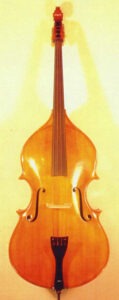

For the construction of this instrument, we used only top-quality materials, as with all our basses.
The fact that the order came from one of the world’s greatest double bassists made every part of the work an immense joy.
Professor Karr liked the unvarnished model he tried at the Atelier very much and requested that his instrument follow the same design.
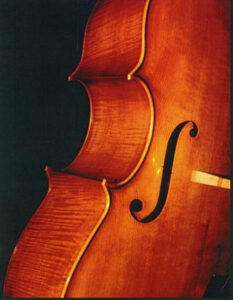
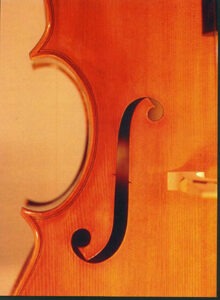
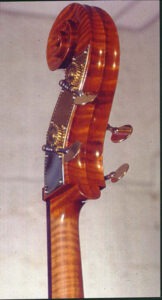
When building a commissioned instrument, every detail is taken into consideration.
The musician must feel completely at ease, so some measurements need to be taken before starting construction.
Every person has their own ergonomic profile, which must be respected in the making of an instrument.

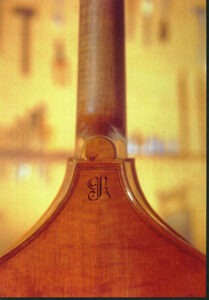
I added a personalized detail at the base of the button.
Every instrument I make has a feature that sets it apart, and in this one, I inlaid Gary Karr’s logo in ebony.
When building a custom instrument, monitoring the process and creating such personal touches is extremely important.
Creating this instrument was one of the most fulfilling and growth-inspiring moments in our Atelier.
I was present at his farewell concert in Indianapolis, and Gary has always been a great friend.

The day Gary visited the Atelier and commissioned his double bass…

… and many years later, in Indianapolis, USA.

Photo sent by Gary a few years after receiving the new instrument.
Some of Gary Karr’s thoughts on the instrument built for him:
“The varnish is truly beautiful and of high quality, like that of the old masters.”
“…the wood is excellent.”
“…it is very practical.”
“The sound of the bass is like a pleasant voice.”
“…your work is very artistic and reflects the soul of a great master.”
“Thank you for bringing this bass into the world and for allowing it to enrich my life.”
“Paulo is an artist of the highest order. He brings to the art of bass making a sensitivity and deep passion that not only enhances the beauty of our instrument but embraces the performer as well.”
“The most eminent bass maker in Brazil and one of the greatest luthiers in the world.”
“I’m honored to know him.”
Marcos Machado
Marcos hails from Bagé, Rio Grande do Sul, and has built an international career as a soloist, teacher, and chamber musician.
He is a professor of classical and jazz double bass at the University of Southern Mississippi in Hattiesburg and principal bassist of the Meridian Symphony Orchestra.
A virtuoso endowed with remarkable talent and musicality.

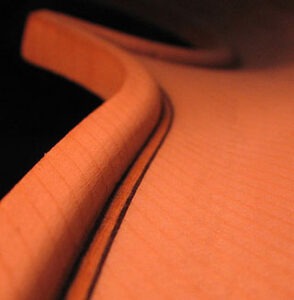
Detail of the “rope” style edge.
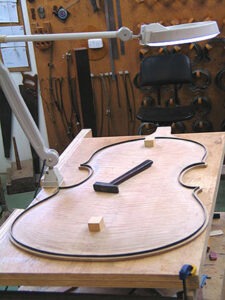
The back being purfled.

For personalization, I crafted an “M” at the end of the fingerboard and, later, another “M” in negative at the end of the tailpiece with the fingerboard.


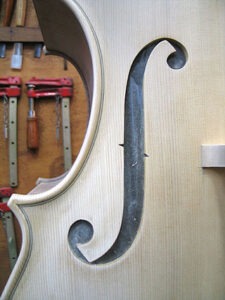
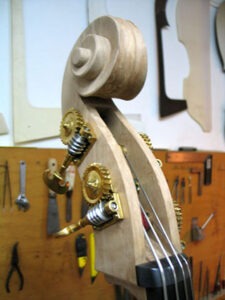
The double bass assembled, played, and ready, before heading to the ultraviolet chamber and then being varnished.
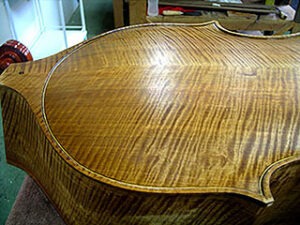
The beauty of the wood truly impresses.
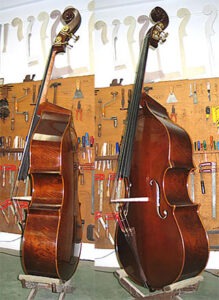
The double bass finished, on the day Marcos came from the USA to pick it up.

This instrument was built with our Adjustable and Removable Neck System.

The edge is slightly lighter than the rest of the wood, giving a very soft outline.


A special moment: playing, for the first time, a double bass made exactly as envisioned.
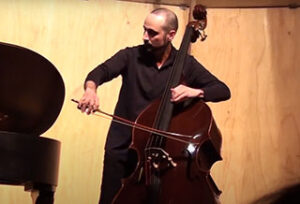
Veja vídeos da estreia deste instrumento clicando here.
Matthieu Hébrard

The instruments of the Frenchman Matthieu and our Sizão Machado were built together.


Matthieu’s is a 7/8 four-string double bass, and Sizão’s is a 3/4 five-string.



We consider these basses “siblings.”




Matthieu on the day the bass was played for the first time and was ready to be varnished.

The bass in the ultraviolet light chamber, being “tanned” before varnishing.

With the varnish already dry on the day the bass left the Atelier.


It’s hard when the instrument finally goes to its new home, but the joy of seeing a satisfied musician is immense.
Sizão Machado

It seems that Sizão is very pleased with the construction of his double bass.
Building an instrument for a musician of this caliber is an honor and a great satisfaction for us.



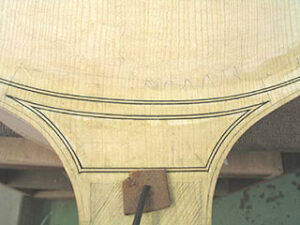


Details of the purfling application and the already purfled edges.
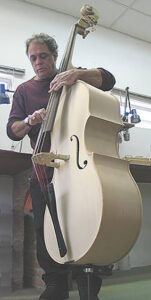

The mutual respect and affection among friends make our work an incomparable pleasure.
One of the advantages of commissioning an instrument is the ability to follow the construction process and play the bass before varnishing, allowing for some personal taste adjustments.
Below are some photos of the finished instrument.






All the details that make our double basses unique pieces.


The joy on our clients’ faces gives us the certainty of a job well done.

Watch several of Sizão’s performances with his bass here.
Learn more about Sizão Machado from his own promotional text:
A self-taught artist and creator of a musical language that goes far beyond the realm of his instrument, bassist Sizão Machado is internationally recognized for his performances alongside Chet Baker, Herbie Mann, Elis Regina, Jim Hall, Chico Buarque, Dori Caymmi, Djavan, Milton Nascimento, Ivan Lins, Joyce, Flora Purim and Airto Moreira, Roberto Menescal, Noite Ilustrada, Jean & Paulo Garfunkel, the Jobim Family, Paulo César Pinheiro, and many others, always leaving his mark wherever he plays.
His conception, rhythm, and “violinistic” harmonizations transposed to the double bass, combined with exceptional taste and sophistication, make his unmistakable style recognizable in any musical genre. This is a privilege reserved for few and truly great instrumentalists.
In addition to his performances on stages around the world, Sizão has participated in the recording of over a hundred albums with a wide variety of artists. In his solo album, *Quinto Elemento*, Sizão Machado compiled original compositions and carefully selected pieces from his eclectic career. Highlights include *Stanats*, an unreleased theme by maestro Moacyr Santos, *Amparo/Olha Maria* by Tom Jobim, Chico Buarque, and Vinícius de Moraes, recorded with six double basses, and *Anu Preto*, *Quinto Elemento*, and *Samba da Mãe*, of his own authorship.
Currently, in addition to running his own studio, In Sonoris, Sizão presents his work in various formations alongside great instrumentalists and accompanies performances and recordings with Quinteto Sambazz, Terrêro de Jesus, singer Renato Braz, and composers Celso Viáfora and Jean & Paulo Garfunkel.
Sizão Machado teaches courses in musical sensitivity, band practice, and instrument instruction at the Tom Jobim Center for Musical Studies (formerly Universidade Livre de Música – ULM) and at Souza Lima Berklee College.
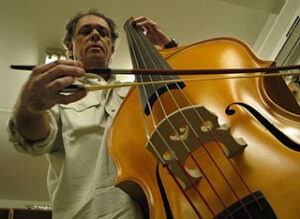
Luiz Chaves

I hold dear the memory of my beloved friend Luiz, and for that reason, I keep these pages to always remember a joyful and happy Luiz with his instrument, which I built with so much pride.
Luiz was an affectionate person who loved spending afternoons at the atelier, chatting and laughing with us.

Below, photos of the construction of this instrument.



Playing the instrument before varnishing is one of the advantages of commissioning its construction, as some adjustments can be made.


The varnishing process with varnish prepared by us, using our own formula


Between coats, the instrument basks in the morning and late afternoon sun.


The long-awaited day of picking up the instrument and taking it home.

The first performance of the Zimbo Trio with the double bass.

Jorge Helder

An internationally recognized musician of great talent, Jorge needs no introduction to any double bassist.
Building this instrument strengthened our friendship.


The scroll, freshly carved, and one of the edges of the top, already purfled.


Throughout the varnishing process, the double bass is alternately placed in the gentle morning and afternoon sun.

The bass, nearly finished, in the varnish room, drying alongside other instruments in the same stage.

Jorge has already made numerous recordings and performances with his new bass.


It wasn’t just Jorge who fell in love with the instrument. The “Caviar Left” also recognizes a fine instrument, and during a season in São Paulo, Chico Buarque had the pleasure of “playing” our bass.
Edvard Debess
Another international musician commissioning the construction of a new double bass.

This is Edvard Nyholm Debess, a double bassist from the Faroe Islands (near Denmark).
Edvard came to Brazil to commission the construction of his new instrument and spent over a week in our country.
His bass was built, and he returned to pick up the finished instrument in February 2006.

Edvard tries out a bass built in the Atelier and confirms the expectations he already had for the instrument. His new bass would be a 3/4 with four strings.

Playing with Célio Barros.
The visiting room was filled with the sound of two instruments built by Paulo Gomes.

This is Tórshavn, Edvard’s hometown in the Faroe Islands.
Though he has lived elsewhere, he always returns to his roots.

In addition to being a jazz double bassist, Edvard is the principal bassist of the Faroese Symphony Orchestra, composes music for his CDs, and writes for various ensembles.

Edvard is familiar with some of our music as he is part of the Gismonti Project with Egberto Gismonti, Jonas Johansen, and Flemming Agerskov.

Edvard at the Workshop, playing the fully completed instrument.



Edvard is a highly talented musician and a really great guy.
He came with his family, and we became great friends.

Birgit (his wife), Edvard, and Edna experiencing a carnival dance.

Birgit, Lisa, Iben, and Edvard.
The whole family, along with Paulo, at a restaurant.
This is the first email Edvard sent when he arrived home with the instrument:
“Hey Paulo, a million thanks for all your help, kindness, and hospitality when we were in São Paulo.
All of you made our stay memorable for the entire family 🙂
We had a wonderful trip to Brazil and enjoyed every minute!
The bass made the journey without a scratch, and I didn’t even pay any excess weight fees anywhere.
We arrived on Thursday, and by Friday night, I started a studio session with the new bass.
I intended to record with two tube mics, but ended up using just one microphone, and it sounded great.
The tone is so clear, clean, and articulated, and the deep tones keep developing over time. The more I play, the richer the sound becomes!
Moreover, the shape, size, and varnish suit me perfectly, so if you aimed to infuse some of my musical personality into this instrument, I think you succeeded brilliantly.
Excellent work, Paulo. Thank you for your tremendous effort on this bass.
I’m deeply grateful and will take good care of the instrument!”
Daniel Marques
Another instrument built to “live” abroad.
This bass was commissioned by Daniel Marques, who resides in Florida, USA.
Since he was far away during the entire construction process, he couldn’t personally oversee the work.
To add to the challenge, Daniel is left-handed, so I had to “play” the bass myself to achieve the best setup.
For me, it’s very difficult to play anything with the strings reversed, but the challenge was the best motivation.

Details of the edges with perfect fittings

Daniel’s bass, a 7/8, behind Marcos Machado’s 3/4. Both basses were built together.








The joy of creating an instrument is always present in every stage of the construction.
The only issue is that, since Daniel is left-handed, the bass has the soundpost and bass bar reversed, and with the strings also inverted, it’s impossible for me to play anything.


I hope to have photos of Daniel playing the instrument to share here.
This bass is another one heading far away, and it’s always hard to see the instruments leave.

Taking advantage of another work trip to New York, I personally brought the instrument to the USA and delivered it to Daniel at the Blue Note, where we went to see my friend Ron Carter.
It was a very special night for both of us.
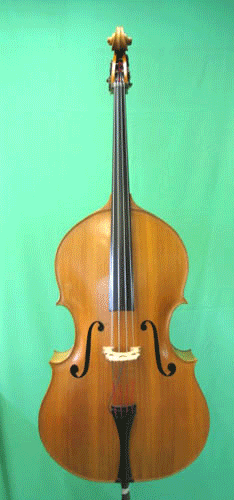
Above, a 7/8 from 1990.
This is probably the bass that appears most frequently in CD and DVD recordings and live concerts. It has been played by some of the finest musicians from Brazil and abroad.
Marc Johnson released a solo album in 2021, Overpass, recorded with this bass, featuring several pieces composed on the instrument.
Ron Carter has also recorded with this double bass, among many other musicians.
This instrument has been featured in several books on lutherie, and many photos of it can be found on the website.

On the left, a 7/8 from 1990.
This is probably the bass that appears most frequently in CD and DVD recordings and live concerts. It has been played by some of the finest musicians from Brazil and abroad.
Marc Johnson released a solo album in 2021, Overpass, recorded with this bass, featuring several pieces composed on the instrument.
Ron Carter has also recorded with this double bass, among many others.
This instrument has been featured in several books on lutherie, and many photos of it can be found on the website.
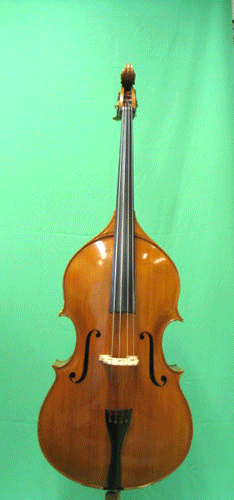
The 3/4 model on the left was built for my late dear friend Luiz Chaves in 1998.
This double bass was also featured in various recordings and performances and, like all of our basses, was built according to an original design of our own creation.

The 3/4 model above was built for my late dear friend Luiz Chaves in 1998.
This double bass was also featured in various recordings and performances and, like all of our basses, was built according to an original design of our creation.
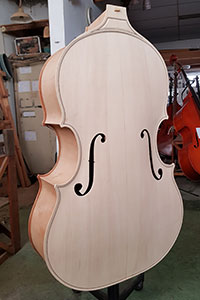
How to Order your Instrument
It’s easy to commission the construction of a double bass and have an excellent instrument at a fair price.
Building an instrument takes about six months of fully handcrafted work. The materials are imported and of the highest quality and origin.
Anyone interested simply needs to contact us. There is always a waiting list, and instruments are built in the order they are commissioned.

We consider the music style to be played and the musician’s body size, among other individual details.
Most of the instruments we’ve built in recent years include our Removable and Adjustable Neck System.
The entire construction process can be followed by the musician step by step, either in person or online.

Look at this website for some of the Instruments Built in our Workshop.
How to Order your Instrument
It’s easy to commission the construction of a double bass and have an excellent instrument at a fair price.
Building an instrument takes about six months of fully handcrafted work. The materials are imported and of the highest quality and origin.
Anyone interested simply needs to contact us. There is always a waiting list, and instruments are built in the order they are commissioned.

We consider the music style to be played and the musician’s body size, among other individual details.
Most of the instruments we’ve built in recent years include our Removable and Adjustable Neck System.
The entire construction process can be followed by the musician step by step, either in person or online.

Look at this website for some of the Instruments Built in our Workshop.
Other Built Instruments
Other Built Instruments
Snake Violin 1993
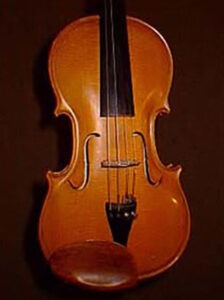
This violin was custom-built for my friend Atilio Marsiglia.
After completing a neck graft, a procedure in which the neck of the instrument is replaced while preserving the original scroll, for Luiz Chaves’s Clodot double bass, the leftover wood was used to build this violin.

The back, neck, and ribs all come from the same piece of wood: Acero (maple).
The top is made of high-quality spruce, and the fittings are ebony.
I had already sketched a few ideas for a “serpent” instrument, and I made this model a condition for returning to violin making (I built four while learning with Bertelli), as I had no interest in making a standard, traditional violin.



The scroll was carved into the stylized head of a cobra, alert and poised to strike.
The Fs (the sound holes found on the tops of all bowed string instruments) complete the concept, as they were replaced by two upright snakes facing each other.
Building an instrument outside your area of specialization is both a challenge and a unique learning experience.
Only the years I spent learning exclusively about violins with my teacher Bertelli allowed me to take on this project.
This is the only violin ever built in my workshop, and I don’t plan on building another, which adds even more to its value.
To carve the scroll, I researched various species of snakes and found the cobra to have the ideal shape. The hood on its head gave the lines a balance of stylization and realism.
The snake’s expression and posture give the instrument a commanding presence, while the beauty of the wood enhances its elegance.
The temptation to add too many details is always there, but it’s better to include just a few—enough to make the instrument unique without compromising its sound or beauty.

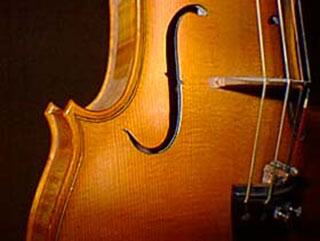
The Fs were based on a 1689 Stradivarius model, then only slightly modified at the ends to transform them into snakes.
This ensures the same acoustic effect as a traditional F-hole.
At first glance, the instrument appears to follow a standard model—but as soon as the eye lingers, its unique shapes become clear.
Basses for Children

Most great musicians begin their studies before adolescence.
Some, in rarer cases, have their first contact with their instrument at the age of five, four, or even three—so by the time they reach adulthood and begin their professional careers, they already have over ten years of specific training on their instrument.
This early start allows them to develop the technical and artistic skills needed to perform in concerts or join symphony orchestras, chamber groups, symphonic bands, or even to become internationally recognized soloists.

With large instruments, however, practical study is only possible once the student is old enough—and physically large enough—to begin learning.
This is the case with the double bass, and it’s the reason this model for children was created.
The problem with the double bass is easy to observe, especially in youth orchestras, where we often see children under seven playing violin, flute, or other instruments, while the double bass players are at least sixteen or tall enough, meaning a gap of about ten years.
Although simpler in its construction, this small double bass is entirely hand-carved, with no parts made from laminated wood.
Its proportions were carefully calculated to allow for normal technical development on the double bass, with string tuning and tension corresponding to that of a ¾ or full-size instrument, so that transitioning to a larger bass feels as natural as possible.

The lack of this type of instrument creates a real need and interest among music educators.
In Brazil, we have a large number of youth orchestras and chamber ensembles where such a small bass is essential.
There are also hundreds of conservatories across the country, as well as private teachers who could begin teaching younger children.
The children’s double bass prevents young students from starting on the cello, which involves a completely different technique.
The boy in the photos is my nephew, Renato Burin, at age 9.
Slide Guitar

I used a 5-liter beer keg to build this instrument.
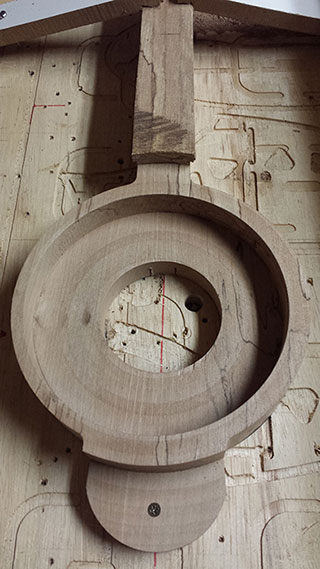
The neck is made from a single piece, along with what would be the top of the instrument, and it was reinforced with carbon fiber rods.

The fingerboard was made as a separate piece.

I added some ebony inlays to give it a Hawaiian instrument feel, since this type of instrument is also known as a Hawaiian guitar.

I installed a pickup, jack, and bass/treble volume knobs on the side of the can.
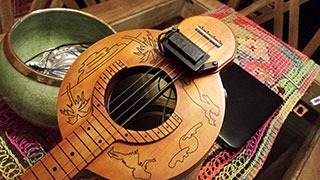
You can see the two carbon rods running through the soundhole beneath the strings.

It’s a fun instrument to play.
This Hawaiian guitar was used in the video celebrating the 40th anniversary of the Workshop.
Click here to see this instrument in action.
Electric Bass 1996
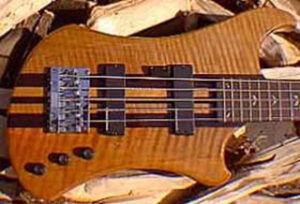
I built this instrument for myself, and it’s the only one of its kind ever made in the Workshop.
Since I’ve always enjoyed playing electric bass as well as acoustic, and only had a 4-string, I decided to make a 5-string for myself.
The fifth string was originally a low B, so the tuning was: G, D, A, E, B. Later, I changed it to include a high C string instead, resulting in the tuning: C, G, D, A, E.

This instrument features woods from three continents: European maple, African wenge, and pau santo and grumixava from the Americas.
The body is made from seven alternating sections—three of pau santo and four of grumixava.
The neck uses four pieces of maple, interspersed with three pieces of mahogany.
The fingerboard is wenge with abalone inlays and brass alloy frets.
The tuning machines and bridge are Gotoh.
The pickups are active Seymour Duncan Soapbars, and I use Rotosound strings.
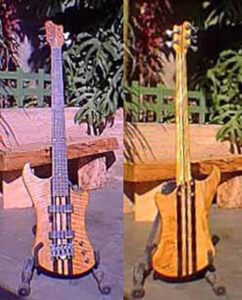

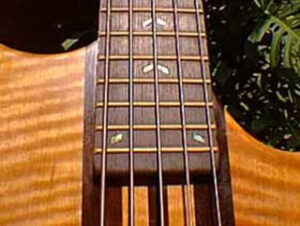
I designed the model myself, aiming for a light and comfortable instrument.
After building several acoustic double basses, this project felt extremely simple and easy.
The body, even with its seven-part construction, is very straightforward, as it’s solid and doesn’t require thickness calculations and other considerations typical of acoustic instruments.
The neck is smooth and comfortable, and the instrument is well balanced, so it doesn’t tip forward, as often happens with 5- or 6-string basses.
Playing this instrument is one of my hobbies.
Viola da Gamba 1991

The Viola da Gamba, like the entire Gamba family, was a precursor to the double bass, along with the violin family. This is easy to observe:
– Double basses with flat backs, a bend near the upper block, and no corners in the middle ribs are derived from the Gamba.
– Double basses with carved backs and corners in the middle ribs are “descendants” of the violin and its family.
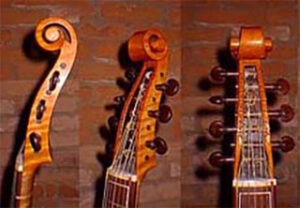
I build my double basses in the Italian style, following the lineage of the violin family.

This particular viola was commissioned by Eduardo Klein.
It is a 7-string bass viol from the Renaissance period.
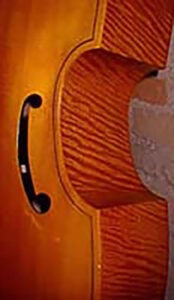

The top of this instrument was made from wood that would otherwise have been discarded during the making of a double bass top.
Before cutting the top for the double bass, I designed and developed a curved saw system.
Working with extreme care for a week, I was able to extract the two pieces that would become this Gamba top from a single block of wood—wood that would typically yield only one double bass top.

wood—wood that would typically yield only one double bass top.
Making the most of such fine material should be both a goal and a responsibility in the practice of lutherie.
Several details were carefully considered to remain faithful to the historical period, while also incorporating the benefits of later discoveries in lutherie.
Every improvement brought about by the development of lutherie—from the earliest Gambas to today—was applied to this instrument.
The neck joint, which in the past was imprecise, fragile, and assembled using hammered iron nails, was made as in so-called “modern” instruments: with precision, strength, and using only a perfect fit and glue.
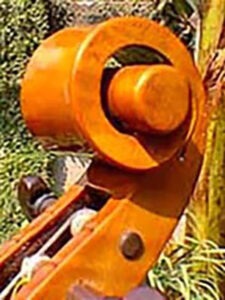
The scroll is quite different from those on modern instruments.
Besides having a different design, it is also hollowed out.
The model for this viola was designed by me, based on research I did at the time using various texts on the subject.
Carving this scroll was a great pleasure—not only because of the challenge, but also due to the beauty of the wood and the model.
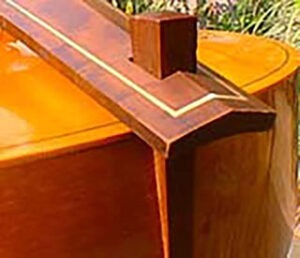
Another detail, quite unlike modern instruments, is the way the tailpiece is attached.
In the Gamba, there is no endpin (the adjustable rod found on double basses and cellos), nor a tailgut (the steel cable that holds the tailpiece to the endpin).
Instead, the tailpiece is held in place by a wooden joint inlaid into the body of the instrument.
Baroque and Renaissance instruments were always richly decorated, often with purfling and inlays.
This viola was purfled after the instrument was already closed.
As I always do when building an instrument, I added a distinctive personal touch. At first glance, it may seem like a decorative flourish on the back of the viola.

Since the musician who commissioned the instrument was named Eduardo Klein, I decided to create an anagram with his initials in the purfling.
I wanted to give the purfling near the button area a more elaborate finish, but to keep the design symmetrical, I made it so the initials E and K would only be noticeable when looking at the instrument from the side.

In the photo above, you can see the letters E and K emerging from within the design.
Ukulele

By the year 2020, I had already undergone surgery on five fingers and my left elbow.
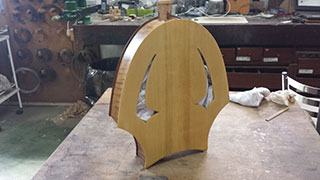
Before one of those surgeries, knowing I would need to take a break from working and playing for a while, I decided to build this ukulele so I could have something to enjoy during my recovery.

I chose a ukulele because it’s very light to play, has synthetic gut strings, and works well for accompanying other musicians, or my own voice.


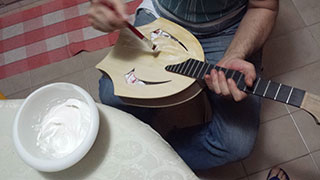
The ukulele was made with very beautiful woods and finished with the traditional egg-white-based sealer used in Italian lutherie.

The varnishing process begins, and Edna is doing the heavy lifting.
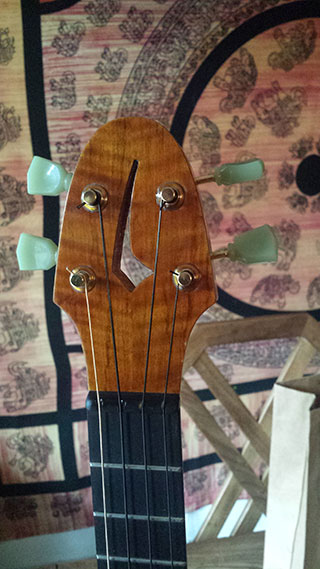
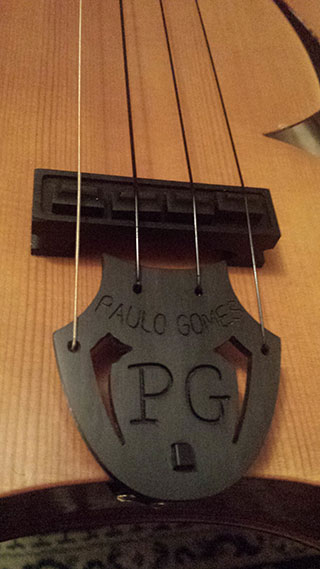

I designed this model myself because I never quite adapted to the standard ukulele shape, which is essentially just a smaller guitar.
With the traditional model, the instrument tends to “dance” on your leg and feel uncomfortable. In this version, the curves fit perfectly to the body—the lower one rests on the thigh, and the upper one on the forearm.
This way, the instrument stays in position, and the hands remain completely free.
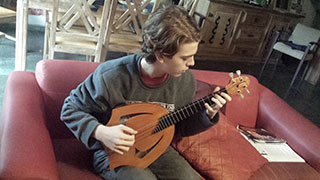
As usual, Artur was one of the first to play the instrument while it was still “warm.”
This ukulele appears in the video celebrating the 40th anniversary of the Atelier, and you can see it here.
Snake Violin 1993

This violin was custom-built for my friend Atilio Marsiglia.
After completing a neck graft, a procedure in which the neck of the instrument is replaced while preserving the original scroll, for Luiz Chaves’s Clodot double bass, the leftover wood was used to build this violin.

The back, neck, and ribs all come from the same piece of wood: Acero (maple).
The top is made of high-quality spruce, and the fittings are ebony.
I had already sketched a few ideas for a “serpent” instrument, and I made this model a condition for returning to violin making (I built four while learning with Bertelli), as I had no interest in making a standard, traditional violin.



The scroll was carved into the stylized head of a cobra, alert and poised to strike.
The Fs (the sound holes found on the tops of all bowed string instruments) complete the concept, as they were replaced by two upright snakes facing each other.
Building an instrument outside your area of specialization is both a challenge and a unique learning experience.
Only the years I spent learning exclusively about violins with my teacher Bertelli allowed me to take on this project.
This is the only violin ever built in my workshop, and I don’t plan on building another, which adds even more to its value.
To carve the scroll, I researched various species of snakes and found the cobra to have the ideal shape. The hood on its head gave the lines a balance of stylization and realism.
The snake’s expression and posture give the instrument a commanding presence, while the beauty of the wood enhances its elegance.
The temptation to add too many details is always there, but it’s better to include just a few—enough to make the instrument unique without compromising its sound or beauty.


The Fs were based on a 1689 Stradivarius model, then only slightly modified at the ends to transform them into snakes.
This ensures the same acoustic effect as a traditional F-hole.
At first glance, the instrument appears to follow a standard model—but as soon as the eye lingers, its unique shapes become clear.
Basses for Children

Most great musicians begin their studies before adolescence.
Some, in rarer cases, have their first contact with their instrument at the age of five, four, or even three—so by the time they reach adulthood and begin their professional careers, they already have over ten years of specific training on their instrument.
This early start allows them to develop the technical and artistic skills needed to perform in concerts or join symphony orchestras, chamber groups, symphonic bands, or even to become internationally recognized soloists.

With large instruments, however, practical study is only possible once the student is old enough—and physically large enough—to begin learning.
This is the case with the double bass, and it’s the reason this model for children was created.
The problem with the double bass is easy to observe, especially in youth orchestras, where we often see children under seven playing violin, flute, or other instruments, while the double bass players are at least sixteen or tall enough, meaning a gap of about ten years.
Although simpler in its construction, this small double bass is entirely hand-carved, with no parts made from laminated wood.
Its proportions were carefully calculated to allow for normal technical development on the double bass, with string tuning and tension corresponding to that of a ¾ or full-size instrument, so that transitioning to a larger bass feels as natural as possible.

The lack of this type of instrument creates a real need and interest among music educators.
In Brazil, we have a large number of youth orchestras and chamber ensembles where such a small bass is essential.
There are also hundreds of conservatories across the country, as well as private teachers who could begin teaching younger children.
The children’s double bass prevents young students from starting on the cello, which involves a completely different technique.
The boy in the photos is my nephew, Renato Burin, at age 9.
Slide Guitar

I used a 5-liter beer keg to build this instrument.

The neck is made from a single piece, along with what would be the top of the instrument, and it was reinforced with carbon fiber rods.

The fingerboard was made as a separate piece.

I added some ebony inlays to give it a Hawaiian instrument feel, since this type of instrument is also known as a Hawaiian guitar.

I installed a pickup, jack, and bass/treble volume knobs on the side of the can.

You can see the two carbon rods running through the soundhole beneath the strings.

It’s a fun instrument to play.
This Hawaiian guitar was used in the video celebrating the 40th anniversary of the Workshop.
Click here to see this instrument in action.
Electric Bass 1996

I built this instrument for myself, and it’s the only one of its kind ever made in the Workshop.
Since I’ve always enjoyed playing electric bass as well as acoustic, and only had a 4-string, I decided to make a 5-string for myself.
The fifth string was originally a low B, so the tuning was: G, D, A, E, B. Later, I changed it to include a high C string instead, resulting in the tuning: C, G, D, A, E.

This instrument features woods from three continents: European maple, African wenge, and pau santo and grumixava from the Americas.
The body is made from seven alternating sections—three of pau santo and four of grumixava.
The neck uses four pieces of maple, interspersed with three pieces of mahogany.
The fingerboard is wenge with abalone inlays and brass alloy frets.
The tuning machines and bridge are Gotoh.
The pickups are active Seymour Duncan Soapbars, and I use Rotosound strings.



I designed the model myself, aiming for a light and comfortable instrument.
After building several acoustic double basses, this project felt extremely simple and easy.
The body, even with its seven-part construction, is very straightforward, as it’s solid and doesn’t require thickness calculations and other considerations typical of acoustic instruments.
The neck is smooth and comfortable, and the instrument is well balanced, so it doesn’t tip forward, as often happens with 5- or 6-string basses.
Playing this instrument is one of my hobbies.
Viola da Gamba

The Viola da Gamba, like the entire Gamba family, was a precursor to the double bass, along with the violin family. This is easy to observe:
– Double basses with flat backs, a bend near the upper block, and no corners in the middle ribs are derived from the Gamba.
– Double basses with carved backs and corners in the middle ribs are “descendants” of the violin and its family.

I build my double basses in the Italian style, following the lineage of the violin family.

This particular viola was commissioned by Eduardo Klein.
It is a 7-string bass viol from the Renaissance period.


The top of this instrument was made from wood that would otherwise have been discarded during the making of a double bass top.
Before cutting the top for the double bass, I designed and developed a curved saw system.
Working with extreme care for a week, I was able to extract the two pieces that would become this Gamba top from a single block of wood—wood that would typically yield only one double bass top.

wood—wood that would typically yield only one double bass top.
Making the most of such fine material should be both a goal and a responsibility in the practice of lutherie.
Several details were carefully considered to remain faithful to the historical period, while also incorporating the benefits of later discoveries in lutherie.
Every improvement brought about by the development of lutherie—from the earliest Gambas to today—was applied to this instrument.
The neck joint, which in the past was imprecise, fragile, and assembled using hammered iron nails, was made as in so-called “modern” instruments: with precision, strength, and using only a perfect fit and glue.

The scroll is quite different from those on modern instruments.
Besides having a different design, it is also hollowed out.
The model for this viola was designed by me, based on research I did at the time using various texts on the subject.
Carving this scroll was a great pleasure—not only because of the challenge, but also due to the beauty of the wood and the model.

Another detail, quite unlike modern instruments, is the way the tailpiece is attached.
In the Gamba, there is no endpin (the adjustable rod found on double basses and cellos), nor a tailgut (the steel cable that holds the tailpiece to the endpin).
Instead, the tailpiece is held in place by a wooden joint inlaid into the body of the instrument.
Baroque and Renaissance instruments were always richly decorated, often with purfling and inlays.
This viola was purfled after the instrument was already closed.
As I always do when building an instrument, I added a distinctive personal touch. At first glance, it may seem like a decorative flourish on the back of the viola.

Since the musician who commissioned the instrument was named Eduardo Klein, I decided to create an anagram with his initials in the purfling.
I wanted to give the purfling near the button area a more elaborate finish, but to keep the design symmetrical, I made it so the initials E and K would only be noticeable when looking at the instrument from the side.

In the photo above, you can see the letters E and K emerging from within the design.
Ukulele

By the year 2020, I had already undergone surgery on five fingers and my left elbow.

Before one of those surgeries, knowing I would need to take a break from working and playing for a while, I decided to build this ukulele so I could have something to enjoy during my recovery.

I chose a ukulele because it’s very light to play, has synthetic gut strings, and works well for accompanying other musicians, or my own voice.



The ukulele was made with very beautiful woods and finished with the traditional egg-white-based sealer used in Italian lutherie.

The varnishing process begins, and Edna is doing the heavy lifting.



I designed this model myself because I never quite adapted to the standard ukulele shape, which is essentially just a smaller guitar.
With the traditional model, the instrument tends to “dance” on your leg and feel uncomfortable. In this version, the curves fit perfectly to the body—the lower one rests on the thigh, and the upper one on the forearm.
This way, the instrument stays in position, and the hands remain completely free.

As usual, Artur was one of the first to play the instrument while it was still “warm.”
This ukulele appears in the video celebrating the 40th anniversary of the Atelier, and you can see it here.
Making – Restoration
Maintenance – Rent
Evaluation – Buy and sell
Specialized in Double Basses since 1980
Monday to Friday
from 10 am to 12 pm and from 2 pm to 5 pm
By appointment only
Rua Marselhesa 387
Vila Mariana – SP
We send only ONE email each month with instruments for sale and new products.
Subscribe below to be added to the list.
© Copyright – 2021 – Paulo Gomes – All rights reserved
Making – Restoration
Maintenance – Rent
Evaluation – Buying and Selling
Specialized in Double Basses since 1980
Rua Marselhesa 387 – Vila Mariana – SP
Monday to Friday from 10 am to 5 pm
By appointment only
We send only ONE email each month with instruments for sale and new products.
Subscribe below to be added to the list.
© Copyright – 2021 – Paulo Gomes – All rights reserved




